





EXCLUSIVE PAINTINGS, SCULPTURES, PHOTOGRAPHY AND TIMEPIECES FROM AWARD-WINNING INTERNATIONAL ARTISTS





 Shadab Khan
Sculpture by Armin Shahhosseini
Photograph by Mahsa Namvar
Shadab Khan
Sculpture by Armin Shahhosseini
Photograph by Mahsa Namvar







EXCLUSIVE PAINTINGS, SCULPTURES, PHOTOGRAPHY AND TIMEPIECES FROM AWARD-WINNING INTERNATIONAL ARTISTS





 Shadab Khan
Sculpture by Armin Shahhosseini
Photograph by Mahsa Namvar
Shadab Khan
Sculpture by Armin Shahhosseini
Photograph by Mahsa Namvar
An insight into the news and trends shaping the region with perceptive commentary and analysis
Dubai-based AIX Investment Group is forging partnerships in the world of sport, leveraging its global appeal to highlight the firm’s business and offerings

Artificial intelligence, machine learning, wearables, and personalised and preventive care – the future of healthcare revealed


A poignant tale of destiny and polygamy— and one man’s personal struggle to come to terms with his two wives and two lives.




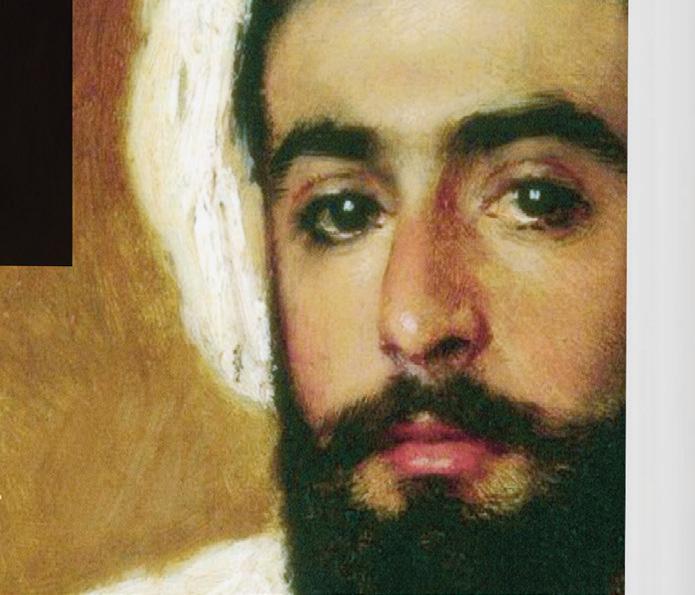


ALL


‘There I was, leading a daily double life …’

Emirates LitFest is back: We look at what the 15th edition has in store for fans p.60

Luxury in focus : Neom’s Sindalah and Trojena are poised to be luxury hotspots p.62

Fashion forward: In conversation with the Arab Fashion Council’s chief strategy o cer p.68



Interviews with entrepreneurs and insights from experts on how the regional SME ecosystem is evolving
Editor-in-chief Obaid Humaid Al Tayer
Managing partner and group editor Ian Fairservice

Chief commercial o cer Anthony Milne anthony@motivate.ae
Editor Neesha Salian neesha.salian@motivate.ae
Tech editor Divsha Bhat divsha.bhat@motivate.ae
Contributing editor Zainab Mansoor editorial.freelancer@motivate.ae




Senior art director Olga Petro olga.petro @motivate.ae

Art director Freddie N. Colinares freddie@motivate.ae
Cover: Freddie N. Colinares
General manager – production S Sunil Kumar
Production manager Binu Purandaran


Production supervisor Venita Pinto
Publisher Manish Chopra manish.chopra@motivate.ae
Digital sales director Gurjeet Kaur Gurjeet.Kaur@motivate.ae
Sales executive Sonam Sharma sonam.sharma@motivate.ae
Group marketing manager Joelle AlBeaino joelle.albeaino@motivate.ae
“The Dubai Economic Agenda D33 includes 100 transformative projects, with economic targets of 32 trillion dirhams over the next 10 years, doubling our foreign trade to reach 25.6 trillion dirhams and adding 400 cities as key trading partners over the next decade”
Sheikh Mohammed bin Rashid Al Maktoum, vice president and prime minister of the UAE and the ruler of Dubai













Following 2022, which was a challenging year for investors, 2023 will likely bring more trials. However, there are reasons to be optimistic, and growth will be found by the astute.

Central banks have shown they will no longer fuel the continued growth of economies but are happy to force a recession, where needed, to cool inflation and reduce government borrowing. Interest rates will likely continue to rise, but at a lesser rate than initially expected. Inflation will reduce and settle but at a point higher than the targets governments and central banks set.
With no apparent end to the crisis in Europe, energy prices and economies in Europe and the UK look set to factor heavily in any prospects for the economic outlook. The year 2023 will be a challenging year for economies like those in the Eurozone, UK and US, but many experts expect more positive things for the markets.
It is worth remembering that sentiment and market prices tend to move ahead of, and quicker than, economies, often forecasting recessions and recoveries by leading the way. This means that whilst economic growth may be slow, market growth and recovery are still possible.
Bad news, fear of inflation, and poor corporate results have already been factored into stock prices. There are signs of an easing in the global supply chain disruption, with air and sea freight prices beginning to fall. Backlogs caused by lockdowns are easing, and this will help increase consumption.
China could help Asia have a good year, as it continues to reopen regionally and provides further stimulus for recovery.
Bond markets have changed with the speed at which governments increased interest rates over the last year, but there is now a way forward that means growth and quality are no longer two different things. Short-dated or indexlinked bonds are favoured when looking for overall yield.
The yield curve is currently inverted, this means that the interest rates on short-term bonds is higher than that of long-term bonds. Usually a good indicator of a recession, the negative yield curve does pose challenges for fixed income investors. Typically, the more risk adverse or conservative that a portfolio is, the higher exposure it would normally have to fixed income investments such as bonds and treasuries.
Over the last year this traditionally stable asset class has been anything but as governments have been raising interest rates with gusto. This does make for an opportunity in short term and index linked bonds as well as giving the potential to buy into bond funds that have seen their values adjusted accordingly
The year will allow investors, governments, institutions and corporations to look at a sustainable
With 2023 likely to be challenging for investors, there are still opportunities for growth
growth model. Sustainable in this context means “not damaging the environment or people”.
An increase in demand for scrutiny of governance in major industries is driving this as well as targets set to reduce climate increases in temperature.
Local and regional economies look set to continue to do better than those in the Eurozone, UK and US. This is led by continued diversification and reinvestment of government assets. Construction and tourism will also continue to thrive, trends show.
Foreign exchange and the rapid strengthening in the value of the US dollar compared to most other currencies will have been felt acutely by anyone importing goods or services from economies pegged to the US dollar.
This increase in value often softens the relative downturn of investments when measured in currencies other than US dollars; it is a double-edged sword. However, investors should look to see what their exposure is to the reverse happening, as their home currencies begin to strengthen.
With careful planning and proper asset allocation, there are plenty of reasons to be optimistic about 2023. Advice should be sought on portfolio currency exposure, length of terms of any fixed interest (bond) instruments and what sector to invest in to pursue growth opportunities.
“FOREIGN EXCHANGE AND THE RAPID STRENGTHENING IN THE VALUE OF THE US DOLLAR COMPARED TO MOST OTHER CURRENCIES WILL HAVE BEEN FELT ACUTELY BY ANYONE IMPORTING GOODS OR SERVICES FROM ECONOMIES PEGGED TO THE US DOLLAR”
Jonathan Brookes, chartered financial planner and partner with Hoxton Capital Management
“BOND MARKETS HAVE CHANGED WITH THE SPEED AT WHICH GOVERNMENTS INCREASED INTEREST RATES OVER THE LAST YEAR, BUT THERE IS NOW A WAY FORWARD THAT MEANS GROWTH AND QUALITY ARE NO LONGER TWO DIFFERENT THINGS. SHORT-DATED OR INDEX-LINKED BONDS ARE FAVOURED WHEN LOOKING FOR OVERALL YIELD”
MAKE MONEY ON EVERYTHING
At the highest level, the five biggest tech-related stocks comprised just over 20 per cent of the S&P 500 in 2000. In 2005, they were only 5 per cent of the S&P 500. The five biggest tech stocks comprised roughly 25 per cent of the S&P in 2022 and are now less than 18 per cent.
In the past, the mega stocks of the S&P 500 have had their growth held back by government intervention to reduce their dominance. We are seeing increased regulation now which may strangle a quick rebound as well as less merger and acquisition activity.
With this in mind, many experts believe that the S&P will recover quicker in the other areas first. It is possible for investors to have exposure to equal-weighted S&P growth rather than relying on that of the capitalisation weighted index.
Information technology still remains an area of growth however, but it is no longer possible to make money on everything. Networking equipment, payment processors and semiconductor equipment remain on the buy list. Corporate spending on these items is anticipated to be stable and will keep demand. Many of these providers are still in strong financial positions with low leverage and high margins.
While Meta (Facebook) may struggle persuading the markets to be excited about the metaverse there is undoubtably still a demand for people to be online. Netflix has seen a surge in new subscribers as well as eight-month highs in its stock value.
INFORMATION TECHNOLOGY STILL REMAINS AN AREA OF GROWTH HOWEVER, BUT IT IS NO LONGER POSSIBLE TO
Investors today are increasingly scrupulous in their due diligence and less prepared to take bets on companies they find difficult to understand

With 2022 in the rear-view mirror, board members and senior executives are turning their attention to the future and the challenges that lie ahead. One of the key questions they must address is: How to maintain or enhance the value of their business in 2023? This task is made more complex by the ongoing economic uncertainty.
Regardless of whether a business is publicly traded, preparing for an initial public offering, or privately funded, the value of the company is ultimately determined by the last share price that investors are willing to pay. And this last share price is essentially a function of two factors: performance and perception.
In today’s volatile economic environment, even companies with strong financial foundations and established track records can experience fluctuations in their valuation due to market dynamics. While these temporary gyrations are often forgotten when economic conditions improve, negative perceptions can quickly spread, causing investors to avoid the company, and leading to a downward spiral in market value.

Furthermore, investors today are increasingly scrupulous in their due diligence and less prepared to take bets on companies they find difficult to believe in. To create a positive impression among investors, business leaders need to show, not just tell, how they are delivering business value. One way to keep the capital markets informed about a company’s performance and manage its perception among the professional investment community is an effective investor relations (IR) strategy.
When developing an IR strategy, it is important to recognise that, despite the evolution of global market dynamics, the fundamental investing principles have remained unchanged for more than 100 years. Investors and analysts still seek to thoroughly assess companies and require ‘meaningful’ information to do so. The most successful companies understand this and focus on three key areas when developing effective IR strategies that can significantly impact the valuation of their company.
It is completely reasonable to want to present your equity story in a manner that is authentic to you. However, investors are logical and analytical individuals who may quickly disregard an overly positive narrative. This often necessitates a shift in mindset from trying to sell your story to simply telling your story. To effectively engage with analysts and investors, it is helpful to consider their perspectives and craft a corporate narrative within the context of the company’s industry. A data-driven approach that outlines the value and performance of the company and compares it to the financial performance and positioning of industry competitors, can be particularly effective.
WHEN
The renowned investor Peter Lynch once offered the following advice for those seeking to emulate his success: ‘Invest in what you know’. This statement highlights the significance of having a deep understanding of the companies in which one chooses to invest. To effectively evaluate a company, analysts and investors must have access to meaningful information about its performance, strategies and opportunities. This is not just about presenting raw financial data but also about communicating a compelling vision that inspires confidence and excitement.
To build trust with investors, it is essential to provide insights into key performance metrics and guidance that allow them to compare your company to the prospects of others in the industry. However, simply providing year-on-year or quarter-on-quarter comparisons is not enough to inspire investment. Management must also demonstrate how the company has achieved these results and outline a clear business strategy that will enable it to capitalise on future opportunities while minimising risk. Most importantly, organisations and leaders must be able to convincingly link their strategic, financial, and operational achievements to future growth potential.
Senior executives often waste their time trying to attract investors who are not suitable for their business. This can be avoided by carefully analysing shareholder registry information and targeting the right investors.
However, it is surprising to see how many organisations prioritise protecting their shareholder registry data instead of sharing this valuable information with investor relations teams. Doing so allows these stakeholders to fully utilise the information and understand the motivations behind
“THE RENOWNED INVESTOR PETER LYNCH ONCE OFFERED THE FOLLOWING ADVICE FOR THOSE SEEKING TO EMULATE HIS SUCCESS: ‘INVEST IN WHAT YOU KNOW’. THIS STATEMENT HIGHLIGHTS THE SIGNIFICANCE OF HAVING A DEEP UNDERSTANDING OF THE COMPANIES IN WHICH ONE CHOOSES TO INVEST”
DEVELOPING AN IR STRATEGY, IT IS IMPORTANT TO RECOGNISE THAT, DESPITE THE EVOLUTION OF GLOBAL MARKET DYNAMICS, THE FUNDAMENTAL INVESTING PRINCIPLES HAVE REMAINED UNCHANGED FOR MORE THAN 100 YEARS
investors’ decisions to invest in the organisation. With this understanding, they can create profiles of potential investors and anticipate what might appeal to them.

In parallel, it can be beneficial to conduct an investor targeting exercise to identify potential gaps in the company’s shareholder register by analysing who invests in the organisation’s competitors. A market feedback assessment, also known as a perception audit, can also be helpful in understanding how the target audience perceives the organisation, its products or services, and its market position. Analysing the results of these exercises can provide valuable insights for enhancing the organisation’s investor relations programme.
It is expected that most organisations will face macroeconomic challenges in 2023. In this environment, investor perception will be a key factor in determining the success of companies in the year ahead. As such, e ective investor relations will be central to protecting and unlocking business valuations. No matter where a company currently stands in terms of its investor relations maturity, implementing the above approach as an ongoing practice can help to build investor trust and confidence, ultimately supporting long-term stock performance. By staying attuned to the expectations of investors and consistently communicating a compelling narrative and sound business strategy, companies can position themselves for success in a challenging market.
The Middle East is di erent – it’s one of the few regions where a ordable growth capital is readily available. It’s also on a mission to transition to more sustainable industries, including financial services.
So what can we expect from financial services in MENA in 2023? We’re not going to try to look into a crystal ball – real innovation is impossible to predict – but we can talk about some trends and about one certainty: there will be a lot of interest in fintech.
Financial services is one of the last business segments to be disrupted by technology. Today’s music industry bears little resemblance to the structure that existed before 1999, when Napster opened the floodgates to digital audio file sharing. Financial intermediation, on the other hand, has yet to be radically changed. That’s partly a function of regulation designed to
“IT IS EXPECTED THAT MOST ORGANISATIONS WILL FACE MACROECONOMIC CHALLENGES IN 2023.
IN THIS ENVIRONMENT, INVESTOR PERCEPTION WILL BE A KEY FACTOR IN DETERMINING THE SUCCESS OF COMPANIES IN THE YEAR AHEAD”ILLUSTRATION: GETTY IMAGES/SESAME Kareem Refaay, managing director, The London Institute of Banking & Finance

protect the consumer. But regulation can cut both ways. Regulators want consumer protection, but they also want more choice, cheaper services and lots of innovation. That means the benefits of technology are coming to finance.
One development that looks set to start making waves in MENA in 2023 is open banking. It’s still in its early days – Bahrain is the only country in the region that has mandated open banking – but the UAE and Saudi Arabia are expected to publish legislation soon, with Egypt, Jordan and Kuwait to follow quickly after that.
Open banking allows consumers to share their current account data with third-party fintechs (including banks) that offer innovative services. For example, consumers could get access to account to account payments, or to an automated tax and accounting tool.

The idea is that they will be able to pick and choose from an ecosystem of financial services that make those services cheaper and better.
The UK was one of the first regions to launch open banking, but uptake has been disappointing. One of the reasons why is that it’s quite clunky to use. Another is that consumers are responsible for checking that the entity with which they share their data is authorised by the regulator.
So, apart from some particularly compelling use cases, like tax and accounting tools, it’s easier for most people just to continue using the payment cards they are used to. UK authorities are due to issue an update on the future of open banking in Q1 this year.
Arguably, the MENA region can learn from the experiences of the UK. As account data is shared via application programming interfaces (APIs), regulators will need to ensure that banks don’t drag their heels on putting good APIs in place. Next, they will need to make sure that the system is easy, secure and intuitive for consumers to use.
BANKS CAN OPT TO PROVIDE ‘WHITE LABEL’ BANKING SERVICES TO NON-BANKS, WHICH THEN EMBED THOSE SERVICES IN THEIR OWN PROPOSITION
The first open banking platform in the region – Tarabut Gateway – already connects a regional network of banks and fintech through a universal API. That should make it easy for those firms to set up compliant open banking services.
What sort of innovation could open banking bring to the region? Meem, which is a digital Shariahcompliant bank that began operations in Bahrain in 2018, already offers open banking. New, Shariahcompliant financial services promise to be popular right across the region.
EMBEDDED FINANCE CAN MAKE LAUNCHING NEW AND INNOVATIVE FINANCIAL SERVICES UP TO 10 TIMES FASTER THAN WOULD HAVE BEEN POSSIBLE FOR A TRADITIONAL BANK ALONE
Open banking will also help with so-called ‘embedded services’. Banks can opt to provide ‘white label’ banking services to non-banks, which then embed those services in their own proposition. It’s not a new idea. Companies such as retailers and car dealerships have been offering banking services like financing for many years, with the underlying banking done by a regulated financial entity. What is new with open banking is seamless data sharing.
As a recent white paper on embedded finance co-authored by The London Institute of Banking & Finance pointed out, it can make launching new and innovative financial services up to 10 times faster than would have been possible for a traditional bank alone. Testing and building prototypes and trying out new designs are all easier and cheaper when a nimble fintech has access to the account data.
But could some regulators in the region decide to leapfrog open banking – and avoid some of the problems seen in Europe – by going straight to open finance? Like open banking, open finance enables consumers to share financial data with third-parties via APIs. But open finance covers all financial data –not just bank current account data. That could lead to an explosion of innovative financial services that bring together all of the financial data on a consumer or an SME to provide something truly new. In particular, it could help firms build more sustainable financial services.
So, as 2023 starts, it’s all to play for in a region that has the luxury of both a financial services industry that is set to innovate and capital to fund that innovation.
“Open banking allows consumers to share their current account data with third-party fintechs (including banks) that offer innovative services. For example, consumers could get access to account to account payments, or to an automated tax and accounting tool”













For companies exploring international business, alternative banking channels could help save a great deal of money, enable growth and offer access to new markets

When it comes to setting up business bank accounts, neobanks and new fintech players have created a massive shi t. They’ve helped startups get their businesses o the ground and opened borders for established firms looking to go global, while providing a specialised and reliable customer experience.

In the UAE, alternative banking adoption is set to grow, with more than one-third of businesses having a digital bank account in 2023.
But is alternative banking the right option for businesses? Here are a few considerations to keep in mind:

Traditional banks began with a physical presence in key locations, such as high streets and malls, and have had to embark on a digitalisation journey over the past decade to keep up with consumer demands. Slowed down by legacy systems and infrastructure, innovation has been an uphill battle.
On the other hand, newer players have been designed with online access as a priority. The digital-first approach leads to less investment in physical infrastructure which, ultimately, creates better, more reliable tools for clients to manage their businesses.
Bank alternatives were generated from the world of startups. Many fintech players were inspired by a real-life problem their founders faced and decided to solve. As a result, they’re easy to set up and o ten designed to solve a specific problem. This flexibility extends to user experience, resulting in streamlined and simplified management of business finances.
Many fintech and neobank commentators believe that the future of finance is a series of startups and scaleups solving specific customer problems, as opposed to the traditional model of one bank for every service.








Many SMEs and innovative startups are looking for financial solutions to support their growth, as they continue to face challenges securing finances through traditional banks.
This, more than anything else, has opened the field to alternative banks, which are more likely to use cashflow-based lending that open opportunities to entrepreneurs who are still in stealth mode or early-stage growth. Overall, alternative banks help democratise the business world by enabling entrepreneurs – no matter where they’re from or how much startup capital they have – to launch and grow their companies.




Alternative banks utilise a di erent mechanism from traditional banks. While traditional banks have a complex business model, alternative banking uses a process called safeguarding.
With safeguarding, money in clients’ accounts is stored separately from the alternative bank’s own corporate finances. Clients’ money is typically kept






















in what are known as tier-1 financial institutions. This type of solution means that the money exists independently of the bank’s own stability and gives customers added confidence.















The traditional way to manage international financial transactions is to have different bank accounts in different countries. For instance, a Euro account in Italy, a Zloty account in Poland, and a Yuan account in China.


Alternative banking providers offer a single multi-currency account, that allows users to send and receive more than 65 currencies across over 190 countries, all from a single dashboard.




Local IBANs allow users to set up local infrastructure without the hassle of trying to open a domestic bank account. With competitive exchange rates, multicurrency accounts, and local IBANs, alternative banking offers business bank accounts for startups looking to go international.








This solves a common problem non-resident founders and entrepreneurs face: without a local passport, you’re often shut out from local banking infrastructure. Thanks to alternative banking, founders and entrepreneurs can now open a local IBAN from wherever they are in the world.
Alternative banks have put a lot of effort into making sure their phone and online support are top notch. Accessing customer support is as easy as swiping a few times on a phone app, or pressing a button on a web-based dashboard.
Some fintechs take it a step further and appoint a dedicated client manager with expert knowledge in cross-border trade.








With a more convenient, swift and reliable service, alternative banking offers just about any financial service that an individual or a business might need with a lower price tag. For companies exploring international business, the versatile newcomers can help save a great deal of money and support with growth and accessing new markets.











ALTERNATIVE BANKING PROVIDERS OFFER
A SINGLE MULTICURRENCY ACCOUNT, THAT ALLOWS USERS TO SEND AND RECEIVE MORE THAN 65 CURRENCIES ACROSS OVER 190 COUNTRIES, ALL FROM A SINGLE DASHBOARDAlan O’Neill Managing director of Kara, change consultant and speaker





















Interest in the rock band Queen has enjoyed a renaissance in recent years. People above a certain age are talking about them again and humming their iconic songs. The Bohemian Rhapsody movie has put the band back on our radar in a big way. I must confess, I had forgotten about many of its greatest hits and I’m thoroughly enjoying the nostalgia that goes with it all.
I was on a long-haul flight this week and the film popped up on the menu in front of me. With Freddie Mercury being played by Oscar-winner Rami Malek, I was engrossed for the full two hours and 13 minutes. Now I won’t attempt to critique it, but I will say that I enjoyed it very much. I found it inspiring, funny and really quite emotional.
The band was initially called ‘Smile’ and the four original members were playing the pubs and clubs circuit, but with limited success. When the lead singer le t the band, it opened up a place for flamboyant Farrokh Bulsara, born in Tanzania to Indian parents, to join the band.
Farrokh adopted the English name Freddie and later became Freddie Mercury. And as you know, the rest is a history of amazing musical success, personal tragedy and a fantastic legacy of great hits from these four business partners.





When Mercury joined, bringing his style, voice and creativity to the mix, the band became a wellfunctioning unit. Each member had a clearly defined role. There was a lead guitarist, a bassist, a drummer and a lead singer. Unlike most organisations, their individual roles were very clear and there was no ambiguity. Even when it came to song-writing, each one’s talent was respected and they each had a go at it.
A ter a few years of global fame, Freddie was encouraged to leave the band and launch a solo career. Although it didn’t work out, he was subsequently welcomed back to the band – just like the ‘prodigal son’. There was of course lots of sulking and raised voices, but the three members were very grown up about it all. Very soon they were back to rehearsals for the famous Live Aid concert, the crescendo of that phase of their career with Mercury.
Partnerships between friends in business can be very challenging. Art in this case imitates real life, as the UAE is full of SME partnerships that were built on great ideas and ambitions. But they don’t all work out.




I know of one organisation that is owned and run by two gents that never speak to each other at all. They operate their business and communicate exclusively through their accountant. Can you imagine the ine ciencies and lost opportunities that go hand in hand with that scenario? Not to mention the personal stress and risk to the business. I have no idea what caused the ri t in the first place, but whatever the reason – it’s bad for business.

You may be starting out on a new venture with some colleagues. Or you may already be up and running as a business partnership. Is there room for improvement in how you work together? If so it might be a good idea now to renew your “vows”.
01. Revisit your North Star and ask yourselves… why are you in business? What is your purpose, your vision and your mission. These questions will help you to get grounded once again.
02. Consider the values or principles that you all hold dear. Undoubtedly, you’ll include respect, integrity, honesty, etc. But expand those words into examples of where they apply in your business. This will help you check in on your culture and bring the behaviours that are expected and accepted to the fore.
03. Shape the most appropriate structure to ensure you deliver your strategy. Start with empty boxes in an organisation chart and profile the required role in each box. Then match up each partner to the best position - and clarify their roles and responsibilities. That exercise might reveal the need for changes to how you currently operate. But if you use your North Star as your guide, that will make those decisions a lot easier.
I know it’s a cliché, but communication is central to the success of any partnership. It’s not easy, particularly when relationships go off track. But remind yourself that there is too much to lose by allowing ambiguity to prevail.
Partners should take time out to discuss their roles and relationship. And as the business evolves they should keep up that level of communication. That’s a recipe for a successful partnership. Now I do appreciate that these conversations can be awkward, but that will only apply to the first one. An objective facilitator would guide you through this process.
Do business leaders think they don’t need to learn anything new after they’ve reached the pinnacle of success? My friend and our non-profit venture mentor, the late President of India, Dr A P J Abdul Kalam, used to agree with my viewpoint that many probably think they don’t.
Every leader, no matter what level, should hone their skills, as all corporate learning systems are at a lag to the speed of business. The pandemic has proven that beyond doubt. In the post-pandemic business world, you will need new skills to survive, and thrive.
Leadership training is a multi-billion-dollar industry globally, and yet most of these programmes fail to deliver the essential leadership skills desired. Enterprises routinely seek outside help to hone up the leadership skills of their employees at different levels. In fact, if you want to get

“Revisit your North Star and ask yourselves… why are you in business? What is your purpose, your vision and your mission. These questions will help you to get grounded once again”
Here’s how to ensure you’re getting your money’s worthDr
TEAMS WITH GOOD EMPLOYEE ENGAGEMENT HAVE 43 PER CENT FEWER QUALITY DEFECTS AND 37 PER CENT LESS ABSENTEEISM
noticed for a promotion to a higher role, you should show some traits of leadership at your current position. And, what is a better way than taking good leadership training to find out what skills you have, and will need?
Newly minted managers will require skills needed to motivate and manage their teams, which are normally not taught well in B-schools. Each of us needs to discover our unique leadership style to effectively align with the organisation we lead and to manage leaders who have varied leadership styles. Recent tectonic shifts in businesses have brought back some new aspects of leadership that were not prominent till then: empathy, psychology and wellbeing – for instance.
The larger ethical issue amongst business leaders is that they don’t “walk the talk”, but expect others to do that. Environmental, social, and governance; and diversity, equity, and inclusion may be big talking points in corporate boardrooms today, but how many leaders do you really see practising it in their personal lives?
Whichever training institute or training modules you use to acquire new leadership skills, there are a few things you need to glean from it in order to ensure that you get your return on time and money investment.
To start with, find out your leadership style (if you already know that, learn how to improve it further). Find out what defines you as a leader. There are thirteen or so leadership styles defined by some institutions, ranging from autocratic to visionary (autocratic or authoritative, affiliative, bureaucratic, coaching, democratic or facilitative, delegative, emergent, pace-setting, servant, strategic, transactional, transformational and visionary) that cover pretty much all types in existence. Where do you fit in?
While there is no single style that will guarantee success in isolation, depending on the organisation, teams and the situation, different leadership styles will find the desired results. However, I can bet 70 per cent of leaders don’t really know what style they have. Within the same organisation, leadership team members will have very different styles. That’s the best example of diversity bringing success. Different styles will be needed for specific situations. Getting to know your leadership style early will help to build on it further for driving results for your role.
Next is to acquire the ability to manage uncomfortable discussions. From firing someone to confronting someone highly political within the organisation, leaders have the toughest test in
ENVIRONMENTAL, SOCIAL, AND GOVERNANCE; AND DIVERSITY, EQUITY, AND INCLUSION MAY BE BIG TALKING POINTS IN CORPORATE BOARDROOMS TODAY, BUT HOW MANY LEADERS DO YOU SEE REALLY PRACTISING IT IN THEIR PERSONAL LIVES?”
confronting and managing uncomfortable discussions. Such situations are hard mainly because there is conflict or some sort of misalignment. Avoiding such discussions will normally backfire.
A good programme would help you with the right resources to address this critical task. The idea is to have a rational conversation, nurture empathy, use critical thinking and manage emotions to solve the problem in a creative manner.
The third is a related area: conflict management. The American Management Association says, on an average, 24 per cent of a manager’s time is spent on managing conflicts. Any area of business can cause a conflict that can disrupt normal work – and it is not just confined to workplaces. A good leadership skill is to identify the conflict and have the foresight to resolve it early. Good leadership training should teach how to do this well, but what’s alarming is that over 60 per cent of managers have never received adequate training in this area. Ask yourself if you have been trained to handle conflicts at work.
Fourth is the skill in building relationships within teams. Jack Welch may have said that he didn’t need to be loved within GE, but great teams need an engaging leader who has the ability to build working relationships. Teams with good employee engagement have 43 per cent fewer quality defects and 37 per cent less absenteeism. Leaders can learn how to share more of themselves during meetings such as stories of relevant anecdotes from the past, how to really say thank you or hold team building workshops, for instance.
The fifth one is something the pandemic has brought to sharp focus: Being agile and adaptive. If one critical thing leaders need for managing the future today, it is the ability to quickly manage the change, as we have witnessed how some companies had quickly mitigated the harsh effects of lockdowns. Roughly right and quick instead of precise and slow is the new mantra. Learn how to ask for resources, how to help you go out of your comfort zone and take quick decisions, how to take responsibility for change and how you can walk the talk on agility.
There are several more skills that can be acquired from a leadership training programme but I will limit it to one last one that is critical in today’s workplaces where wellbeing is a major demand by the Generation-Z workforce. Building mental safety is something every leader must have on his or her plate. Minimising management toxicity at workplaces and building a positive and safe environment for all team members are essential for success – an environment to thrive, learn, contribute and challenge.
Research and advisory are the bedrock of any business success. Over the years, many companies, from across different industries, have benefited from this trend to reach their full potential and the real estate sector is no exception.

The involvement of research and advisory in real estate begins ideally at the concept and feasibility study stage of the project and continues in both an advisory and marketing capacity throughout the development cycle, culminating in the sale, leasing, and property management of the completed project.
While master planned communities, mixeduse projects, development plots, and stand-alone developments benefit the most from research and advisory services, the market research team constantly monitors market movement, property prices, and rental trends and provides comprehensive and timely data that is tailored to each client’s needs and requirements.
These include supply and demand analysis, market sector studies, price benchmarking and indices, trends, and competitor analysis as well as occupational surveys.
To begin, the most important factor to consider when conducting research and advisory is that the assessment of any given plot, project, and/or area is influenced not only by internal factors such as unit size, type, layout, condition, parking, security, facilities, and overall age/state of the building, but also by external factors like surrounding area characteristics, proximity to public transportation, ease of access and supporting infrastructure.
A combination of traditional processes and technology-powered tools are then required. Conducting research through interviews, field and desk research, and internal workshops with valuation, leasing, and property management departments to determine current leasing/sales rates and buyer/tenant requirements is important. On the technological front, real estate-specific software, used to make data provided by official statistical sources make sense, continues to gain popularity, and are of utmost importance as they improve the quality and dependability of research and advisory services, as well as adding value to customers and advisors. Data analytics platforms such as REIDIN use data from the Dubai Development Department (DLD) for example.
Overall, real estate firms should identify opportunities, maximise resources and reduce risks for their clients by offering development and marketing strategic advice, asset disposal/acquisition advisory services, master plan review and advisory services, development consultancy/land use studies and target market identification.

The market value of the property (the price it would fetch if it were put in the market) of property is influenced by a number of factors, including the current market situation, the characteristics of the specific asset, economic and social trends and government regulations. To determine the value, several valuation methods are available, the three most important of which are:
Sales comparison approach: The property being valued is compared to similar properties sold in that area.
Income or investment approach: The property being valued considers the income it generates or could generate.
Cost approach: The property being valued considers how much it would cost to construct an equivalent property, which is a common method used for insurance replacement purposes.
But can people place their trust in research and advisory? In addition to access to external databases, every firm should create an internal database that provides relevant and specific transaction-based market data, which will serve as a key point of differentiation from competitors in the field. This will enable the company to base its advice and recommendations on current market rates, providing a thorough understanding of market dynamics, trends, demand, and occupier requirements across all land use categories.
Another fact is that valuations are typically carried out in accordance with the international guidelines published by The Royal Institution of Chartered Surveyors and International Valuation Standards and adhere to the standards and regulations of the local jurisdictions where appropriate. These standards are designed to ensure both best practice and consistency are at the forefront of any advice provided. As such, we strongly encourage all clients, as a first step, to carefully review the qualifications (both international and local accreditations) of all potential service providers.
Regardless of how much money you intend to invest in real estate, it is always a good idea to conduct adequate and extensive research prior to making a decision, as this will allow you to thoroughly understand the complexities of your prospective purchase.
Many individuals and families engage in philanthropy to give back to the community and instill core values in their younger family members. A recent report by University of Cambridge found that philanthropy and charitable donations by private individuals and families in the Gulf Cooperation Council are estimated at $210bn and expected to increase in the coming years.
For some individuals, defining their philanthropic legacy might feel daunting and out of reach at times, especially given the frequent misperception that charitable impact is measured by a dollar amount. In reality, there are many accessible and rewarding ways to leave a lasting legacy and experience the true joy and fellowship of giving.

The key is to adopt a holistic approach that draws on one’s own connections,
“In addition to access to external databases, every firm should create an internal database that provides relevant and specific transaction-based market data, which will serve as a key point of differentiation from competitors in the field”
Here’s how to create an enduring legacy that’s personal to youILLUSTRATION: GETTY IMAGES/STELLALEVI
interests, passions, and resources. Writing a check is important, but that’s not the only lever to pull to leave a philanthropic mark. Individuals must utilise their intellectual, financial, human, and social resources to make a meaningful difference in the lives of others.
For many philanthropists, donating their time, expertise, and abilities can be a potent method to help the causes that are most important to them.
For example, they might have developed specific skills at work, proficiency in several languages, specialised knowledge gained through interests or even athletic skills that can be taught through coaching.
Thinking extensively about what they can provide the organisations that most closely reflect their values will help them maximise their contribution’s impact.
One of the best ways to scale philanthropic impact is by collaborating with others.

As an example, individuals can join or form a “giving circle” with their friends, family, neighbours and co-workers to combine their charitable giving resources. Giving circles draw members who are eager to collaborate on causes with a common goal. For instance, together they might focus on a certain group of people, such as women and girls; a place, whether a nearby neighbourhood or far-off locale; or a widespread issue, such as racial inequity.
Beyond maximising the monetary contribution of a single contributor, participating in such circles can increase an individual’s knowledge about the issues they care about, refine their best practice sharing skills and expand their personal networks.
Individual donors are critical to an efficient and sustained non-profit sector, accounting for two-thirds of all charitable donations given each year. However,
INDIVIDUALS CAN JOIN OR FORM A “GIVING CIRCLE” WITH THEIR FRIENDS, FAMILY, NEIGHBOURS, AND CO-WORKERS TO COMBINE THEIR CHARITABLE GIVING RESOURCES
Daniel Fleming, managing director and head of Wealth Advisory for MENA, J P Morgan
even experienced donors may feel unsure or apprehensive when considering a financial gift to a new organisation.
Perhaps they are drawn to support the mission of a group promoted on social media or recommended by a friend. Individuals must make an effort to create a personal connection with an organisations they don’t know well in order to feel confident in their donation.
Philanthropists can learn about such organisations through publicly available resources, such as the annual report on the website, press coverage; meet with their board members; volunteer and attend events; and tap into their network to learn about personal experiences with the charity’s mission.
They can also make a small initial donation to get to know an organisation; consider increasing your contributions as the relationship grows.
If they’re not sure how much to offer, they can inquire about the organisation’s main financing needs and average individual donor contributions. Alternatively, they can ask directly: “What do donors like me give?”
Many families engage in philanthropy to actively share their values and inspire lifetime giving in the following generation. Sustainable investing allows families to discuss and express their beliefs through their capital. Best of all, these investments can support both their principles and financial goals: Historical returns from sustainable investing suggest that these opportunities can outperform the market and, in certain situations, generate excess returns. Families can also track how closely firms meet their personal philanthropic goals.
New technologies are being developed that will allow monitoring sustainable investment criteria over time, much like financial reporting mandates the disclosure of auditable, historical outcomes year after year.
While this market is still in its early stages, consumer demand and governmental actions are driving it, creating an environment in which it may be easier than ever to combine a family’s charity and financial goals.
The year 2022 was marked by inflation and headwinds from the pandemic. These factors, along with social and environmental issues, are intensifying the need for philanthropy across the region and the world. By contributing their intellectual, social, and financial capital, philanthropists can make a significant difference in the community.
“Many families engage in philanthropy to actively share their values and inspire lifetime giving in the following generation. Sustainable investing allows families to discuss and express their beliefs through their capital”
Choices are tough. Without wanting to resort to the sophisticated analytical models and frameworks of decision science to structure one’s life, here’s a simple rule that could help
Decisions. Decisions. Decisions. There seem to be so many to make these days, whether it’s the type of milk you want in your coffee to something like the opportunity of working for a new company. Choices are tough. Without wanting to resort to the sophisticated analytical models and frameworks of decision science to structure one’s life, I prefer to use a simpler technique called the ‘Rule of 9’.
It works like this: if you are utterly convinced, then do it; otherwise, ignore it.

Let’s take an example we can all relate to. Open your wardrobe, look at your clothes and ask yourself: ‘Am I ever going to wear this?’
If you are like most people, you have clothes in your wardrobe you have not worn for six months or even one year. Despite asking the question ‘Am I ever going to wear this?’ you’ll keep the clothes. However, if you ask, ‘Am I in love with this?’ this will allow you to eliminate the clutter and create space for something better.
I have a “maybe” area within my wardrobe. All the clothes I am uncertain about wearing, I shuffle to the right side of the cupboard and place a separator between them and the clothes I am using. I then take note of whether or not I have worn those clothes for six months. If I haven’t, I give them away to charity. This rule applies to items like shirts, trousers and sweaters.
You can apply the ‘Rule of 9’ to any decision. As you ponder over what to do; give the option a score between 0 and 10. If it is less than ‘9’, simply ignore it. This allows you to avoid getting caught in the ‘6s’ and ‘7s’ – things you really don’t want to be doing.
What this will mean is that on occasion you may turn something down that was good. That happens in life, but at least you made the choice and it wasn’t forced upon you.
Staying firm to the rule can be tricky, particularly when opportunities start to present themselves. Maybe you get a call from a recruitment consultant about a role you weren’t expecting. What should you do? It seems like an easy choice – apply for it –but does it really match your career aspirations and

where you currently are in life? I’ve had several occasions when I was approached for a more senior role, offering additional money, benefits and responsibility, but it didn’t meet my ‘Rule of 9’, much to the surprise of the executive recruiter. I turned these more lucrative opportunities down, as I assessed them using the rule in the following manner:
I wrote out on a piece of paper the opportunity and how it was different to my existing role.
I set three basic criteria the role should achieve: Is this interesting work? Does the company have a culture of meritocracy? What positive impact will the role have on stakeholders?
I set three advanced criteria the role should achieve: Is this going to be an intellectually challenging environment where I can create new knowledge? Is the role going to allow me to continue my outside passions of writing and teaching? Is the role going to enable me to spend the requisite amount of time I want to with my family and friends?
Generally, when it came to the advanced criteria, the last two items of remaining true to my writing and teaching interests, as well as spending time with family and friends, were not achievable if I took the new role. Executive roles are all-consuming, involving incessant global travel and long periods of time away from the family. For me, it was not worth it – it didn’t meet my ‘Rule of 9’ – so I politely turned the position down.
Everyone is at different stages of the journey when it comes to their personal and career aspirations. What suited me may not suit you, but either way the Rule of 9 is a helpful prism through which to make a decision.
YOU CAN APPLY THE ‘RULE OF 9’ TO ANY DECISION AS YOU PONDER OVER WHAT TO DO; GIVE THE OPTION A SCORE BETWEEN 0 AND 10. IF IT IS LESS THAN ‘9’, SIMPLY IGNORE ITAbdullah Alajaji, CEO and founder of Driven Properties

It probably sounds too good to be true, but Dubai’s real estate market has outperformed all its global competitors in 2022. Transaction value surged to Dhs265bn, compared to Dhs152bn in 2021, a 77 per cent year-on-year increase. In terms of price growth, the property market registered a 29 per cent increase in value, with the obvious outperformer being the ultra-high-end segment of the market.
Buoyed by years of infrastructure and development, Dubai has become a magnet for affluent populations from Europe, Russia, and most recently the Far East. There are no signs that the liquidity that made its way into this market will abate anytime in the near future. The RussiaUkraine crisis has also had a significant impact on attracting investments into the Dubai property market. In addition, a combination of social and economic challenges in Hong Kong, Singapore, and mainland China has helped Dubai quickly propel its market share in areas such as trade, logistics, travel, tourism and finance.
As a result, we now see Chinese investors flocking to Dubai’s property sector after a three-year absence (due to quarantine restrictions since Covid-19). Based on January’s data, we are likely to see investments from China edge by over 100 per cent yearon-year and the overall market registering growth in transaction value as well as price growth in 2023.
But then corporate tax is coming, and an ever more popular question is whether this will have any impact on the property market, especially since Dubai’s main
competitive advantage has always been its tax-haven status. It is worth noting that the 9 per cent corporate tax starting from June 1 is not applicable to investments made by individuals in the real estate ecosystem.

Having said that, one possible outcome of this is property developers choosing to increase their prices to compensate for the impact of taxation on their balance sheet, therefore, pushing property prices upwards and consumers footing the bill.
All in all, the very introduction of this tax is to bolster the balance sheet of the government, which will encourage more infrastructure spending. This will, in turn, enhance investments in the real estate market by both local and international investors. Taking a more general view outside of property, another advantage of the new corporate tax for the UAE is increased transparency, where financial institutions can now make more informed decisions as it relates to the health of a particular business, and therefore lowering its borrowing costs.
Utopia is when all of this is complemented with domestic reforms aimed towards attracting more affluent migration into the city. Permanent residency programmes and golden visa regimes only helped make investment decisions for those wealthy migrants that much easier. This year might bring various changes as we are witnessing the landscape of the region shifting; however, one thing remains certain – this country is developing at an incredible speed, and we have every reason to believe the changes coming are for the better.
How the introduction of corporate tax, a resurgence in demand from China and other key factors will impact Dubai’s property market
IN TERMS OF PRICE GROWTH, THE PROPERTY MARKET REGISTERED A 29 PER CENT INCREASE IN VALUE, WITH THE OBVIOUS OUTPERFORMER BEING THE ULTRA-HIGH-END SEGMENT OF THE MARKET
BUSINESS LEADERS, IN THE RECENT PAST, HAVE WITNESSED SIGNIFICANT DIGITAL TRANSFORMATION AND REMAIN OPTIMISTIC ON POTENTIAL POSSIBILITIES GOING FORWARD
88%
NINE IN TEN BUSINESSES INDICATE THEY ARE ADVANCED IN THEIR ADOPTION OF CLOUD
Migrating strategic workloads to the cloud
WHERE WOULD YOU PLACE YOUR ORGANISATION IN ITS CLOUD JOURNEY?
How would you describe your organisation’s position today in your cybersecurity journey?
42%
WE ARE PROACTIVE IN PROGRESSING AGAINST OUR STRATEGY AND ARE CONTINUALLY EVOLVING
58%
Completed migration to the cloud and are now focused on continuous optimisation and modernisation
Evaluating cloud as an option, but remain primarily on-premises
Piloting workloads and starting to leverage cloud, but at a limited, measured pace
WE ARE BEHIND SCHEDULE, EVEN IF PLANS AND A VISION ARE IN PLACE
To what extent has digital transformation had a positive impact on profitability or performance in the last two years?
Where will your organisation invest the most over the next year and years from now?
Years from now
ALMOST ALL RESPONDENTS SAY THAT THEIR ORGANISATIONS’ DIGITAL TRANSFORMATIONS HAVE IMPROVED PROFITABILITY AND/OR PERFORMANCE OVER THE PAST TWO YEARS
#1
TALENT SHORTAGES challenge complicating the adoption of digital technologies
EMERGING TECH
02 YEARS
the expected timeframe for most businesses to embrace key emergingtechnology platforms such as Web3, metaverse and quantum computing
99% DIGITAL TRANSFORMATION executives have generated returns from digital investments
9 in 10
CLOUD ADOPTION businesses indicate they are advanced in their adoption of cloud systems
58%
CYBER SECURITY cyber security teams admit that they are behind schedule
CUSTOMER EXPERIENCE IS SUBSTANTIALLY MOTIVATING ENTERPRISE INVESTMENTS IN IT AND IS BECOMING SYNONYMOUS WITH DIGITAL TRANSFORMATION. TECH STRATEGIES ARE ANCHORED TO CREATING LOYALTY WINNING EXPERIENCES, TO SAFEGUARD INCOME AND ENCOURAGE [HIGH] LEVELS OF REPEAT REVENUE FROM CUSTOMERS”
—Barry Brunsman, global leader, CIO Center of Excellence, KPMG International and principal advisory, CIO Advisory at KPMG in the US
Clash of the GOATs: Lionel Messi of Paris Saint-Germain (PSG) and Cristiano Ronaldo of Riyadh XI fight for possession of the ball during the friendly football match between the two clubs at King Fahd International Stadium, held on January 19, in Riyadh, Saudi Arabia. PSG won 5-4.












FORGING PARTNERSHIPS BEYOND THE TRADITIONAL REALM OF FINANCE ARE EXPECTED TO YIELD PROMISING RETURNS FOR DUBAI-BASED AIX INVESTMENT GROUP. AND THE RETURNS MAY NOT BE ONLY MONETARY IN NATURE




WORDS























There is no understating the importance of diversification as a sound growth strategy. However, for Dubai-based AIX Investment Group, it is not only a viable economic pursuit, but a means to keep the brand in the reckoning.
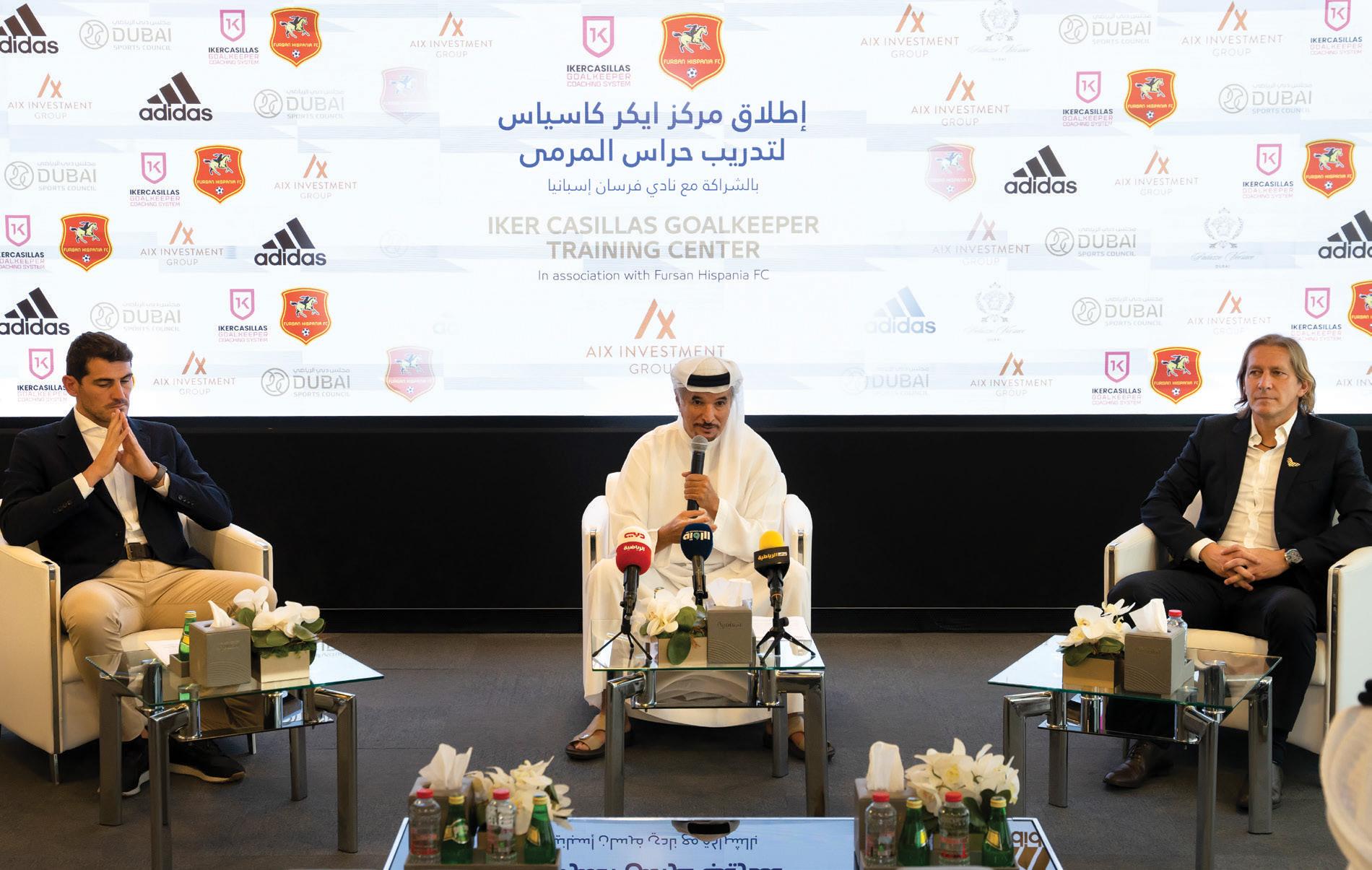
It is this centrifugal approach, coupled with a strong focus to support aspiring talent, that has propelled the advisory firm’s journey beyond the traditional world of finance and helped it forge its first global motorsport collaboration in 2022. The face of this partnership is the 21-year-old American-Spanish single-seat car racer, Brad Benavides of PHM Racing by Charouz, whom AIX has pledged to sponsor for the FIA Formula 2 championship this year.
Racing since the age of 12 and no stranger to speed, Benavides has competed in the Formula Renault Eurocup, the Formula Regional European Championship by Alpine and the Euroformula Open. Having competed in FIA Formula 3 last year, Benavides finished eighth during a Sprint Race at Belgium’s Spa-Francorchamps. This year, Benavides plans to debut and compete in the FIA Formula 2 season, which will kick o in Sakhir, Bahrain on March 3. It will then move in the direction of Saudi Arabia and proceed onto Melbourne in Australia. The campaign, which will comprise 14 rounds, will make its penultimate stop at Monza in Italy, with the season wrapping up at Abu Dhabi’s Yas Marina Circuit in November.
Meanwhile, AIX’s ambitions for cross-industry collaborations haven’t halted at the racetrack – in fact, they’ve transcended beyond street circuits towards stadium midfields. The group is also the main sponsor of Fursan Hispania FC, a football club led by Michel
Salgado, an erstwhile Real Madrid football player. The club provides professional training to young aspirants in the UAE to develop their skills. In 2021, the firm also sponsored RC Celta de Vigo – a La Liga Santander team, with the partnership aligning both entities for a period of three years. The firm is also the main benefactor of the Iker Casillas Academy Dubai, by virtue of a partnership inked with football legend Iker Casillas (see pic above).
“Via its multiple partnerships, the company is proud to be a part of an initiative that improves access to training activities, raises awareness about the significance of sports, as well as supports regional talent,” explains Fadi Dabbagh – board president at AIX Investment Group. “The partnerships assure training of future aspiring talent via programmes devised by industry experts to develop and enhance the skills of players.”

Venturing into unchartered territory yet staying committed to its core strengths has been AIX’s conspicuous strategy. The advisory firm continued to pursue a multifaceted approach and expanded its existing product portfolio by launching a fixed-income instrument - AIX Bond – last year. The security has a 36-month maturity, is listed on the Vienna Stock Exchange and o ers quarterly returns of 4.5 per cent.

The new debt instrument was not only well received by existing investors, but has also become a bridging factor between the company and its potential clientele who historically displayed keenness to invest in similar financial products.

“We have always had structured products [in our portfolio] which have helped us amass a large pool of clientele. However, to add to the requirements of seasoned investors we wanted to structure an o ering that would cater to their needs; therefore, the firm introduced this product, which is a fixed-income high-yielding bond,” adds Harish Prithvi, AIX’s chief operating o cer.
The group recently launched a property-backed instrument – AIX Property Secure – that allows investors to collateralise their investment via a real estate asset, helping generate 20 per cent in rental returns.


Prithvi explains that investors that prefer a form of collateral against their investment instead of standard securities generally lean towards this product. “Investors that hail from the subcontinent and the Middle East and who prefer tangible assets, have shown considerable interest in this product. Such investors prefer financial instruments where properties can be used as a collateral, hence it helps cater to a niche pool of customers,” he notes.
Conventional investment options, such as real estate, have stood the test of time, and continue to gain traction. Real estate was also identified by Knight Frank as one of the top five wealth trends for 2023. This trend is going strong locally as well – in 2022, 80,216 investors registered 115,183 new real estate investments in Dubai, valued at $71.9bn. The past year also saw the completion of 55 real estate projects worth $3.24bn in the emirate, growing 57 per cent in number and 8 per cent in value.
The dynamics of the local economic ecosystem as well as the regulations governing the real estate landscape, have been instrumental in creating a thriving backdrop which has encouraged buyers to choose Dubai for investment purposes.
“In the past three years, property prices in Dubai have risen. Unlike other global markets, Dubai’s property market has had multiple factors influencing the price hike - it was one of the few major economies that opened up to the world [in the wake of the Covid-19 pandemic]. Luxury properties have witnessed additional demand and a notable rise [in prices] too. Not that the general market hasn’t seen an uptick but the appreciation in the luxury market has been more significant. The number of investors looking to invest in Dubai is only increasing and the supply will fall short owing to
THE GROUP RECENTLY LAUNCHED A PROPERTY-BACKED INSTRUMENT – AIX PROPERTY SECURE – THAT ALLOWS INVESTORS TO COLLATERALISE THEIR INVESTMENT VIA A REAL ESTATE ASSET, HELPING GENERATE 20 PER CENT IN RENTAL RETURNS
Via its multiple partnerships, the company is proud to be a part of an initiative that improves access to training activities, raises awareness about the significance of sports, as well as supports regional talent... the partnerships assure training of future aspiring talent via programmes devised by industry experts to develop and enhance the skills of players”
Harish PrithviPhotos courtesy: AIX Investment Group
the demand. Hence, the property market in Dubai isn’t going to slow down anytime soon.”




Furthermore, the company’s optimism towards investment opportunities is not misplaced, as the local wealth landscape o ers a promising snapshot – the UAE represented 10.2 per cent of the Middle East and Africa’s financial wealth in 2021, having risen 6.4 per cent each year since 2016 to reach $0.7tn, a Boston Consulting Group (BCG) report has revealed. Furthermore, the country’s financial wealth is expected to rise to $1tn by 2026.




In 2021, approximately 41 per cent of the UAE’s wealth was derived from ultra-high-net-worth individuals (UHNWIs), who were worth more than $100m. This is expected to rise to 43 per cent by 2026. Meanwhile, people with above $1m in wealth held 28 per cent of the country’s wealth in 2021, the report added.







A number of overwhelming challenges – whether environmental, health-related or economic in nature – have








AIX Investment Group has forged local alliances to cement its presence, one of which is its strategic partnership with UAE-based businessman and CEO of Al Habtoor Trading Enterprises and RKHBC, Rashid Khalaf Al Habtoor. Recipient of a leadership award from Dubai Chambers and honoured by Dubai Business Council four times, Al Habtoor has established over a 100 partnerships and joint ventures with local and global firms.
“Joining forces with AIX Investment Group, who is considered a key player in the investment sector, was a natural move to contribute and to further develop and expand its operations locally as well as internationally,” says Al Habtoor.

AIX’s Dabbagh builds on it: “This strategic partnership comes in line with our strategy to build strong relationships and adds value to our expansion plan by strengthening our position as an innovative and regional player in the investment landscape.”
dominated global discourse in recent years. These challenges, be it the Eastern European crisis, soaring interest rates or the a termath of the pandemic – have not only propelled businesses and economies to change course and adapt but have also, in a relatively inconspicuous way, altered the approach and preferences of individuals and investors.
“Long before the current market state, we sailed through a three-year pandemic period. This has already changed the risk appetite of investors – it has been a global behavioural change that has dictated avenues where investors would plough their money. A lot of them have cashed in on the downtrend that came with the pandemic in 2020,” notes Prithvi.
“As for the investment trends that will dominate the current year, we foresee a rise in demand for low-risk and fixed-income products because of prevailing market conditions,” he adds.
However, irrespective of changing market dynamics and altered investment preferences, Dabbagh dispels long-standing myths around the notion of a ‘perfect investment portfolio’, which he feels is ‘non-existent’. “Investments always come with a certain amount of
UAE REPRESENTED HAVING RISEN 10.2% 6.4% OF THE MIDDLE EAST AND AFRICA’S FINANCIAL WEALTH IN 2021
risk. There is no perfect investment portfolio or product. One can always have a fail-safe structure in their investments,” he says, adding: “At AIX, we have a simple 70/30 rule – have a 70 per cent exposure in a fixed-income portfolio and 30 per cent exposure in a variable-income one. While a variable-income portfolio comes with risk, its fixed-income peer has almost none. Therefore, the inherent risk an investor is exposed to, on account of his/her variable investments, is covered by its fixed-income counterpart. This balances the entire portfolio,” says Dabbagh.

AIX pursues a versatile growth strategy not only in terms of product expansion but market penetration as well. The advisory firm, which was set up in Europe a decade and a half ago, plans to strengthen its core o erings, dig deeper in existing markets, and cast a wider net geographically. “Our expansion plans are quite clear – we aim to increase our stronghold in Zurich (Switzerland)

Apart from relentless efforts to improvise its current investment structure and product yields, the company plans to launch a new fund this year, regulated and licensed by the Cayman Islands Monetary Authority in line with the Dubai International Financial Centre (DIFC)”
– HAVE A 70 PER CENT EXPOSURE IN A FIXED-INCOME PORTFOLIO AND 30 PER CENT EXPOSURE IN A VARIABLE-INCOME ONE. WHILE A VARIABLE-INCOME PORTFOLIO COMES WITH RISK, ITS FIXEDINCOME PEER HAS ALMOST NONE”





















and Doha (Qatar) – the two markets AIX has recently launched in. Additionally, we plan to increase our operations and bandwidth within the region, expand our team as well as continue to evaluate new geographic markets this year,” notes Prithvi.




Apart from relentless e orts to improve its current investment structure and product yields, the company plans to launch a new fund this year, regulated and licensed by the Cayman Islands Monetary Authority in line with the Dubai International Financial Centre (DIFC). “The company is also looking into a property fund, that is in the initial stages of development. We are in discussions with several developers across the UAE and expect the product to take shape in the later part of this year,” he adds.
When quizzed on whether ROI (return on investment) reigns supreme among an investor’s priorities, Prithvi responds as only a seasoned financial advisor would. “ROI is a driving factor that motivates an individual to invest, but it’s not the most important element. The first thing any investor generally considers is the structure of the investment, its safety and then the returns.”

“AT AIX, WE HAVE A SIMPLE
The 53rd annual meeting of the World Economic Forum (WEF) that recently concluded in Davos, Switzerland, saw global leaders underscore the need for mainstreaming smart and sustainable climate solutions in urban development to enhance the livability, efficiency and productivity of cities.
Against this fitting backdrop, Egyptbased Magnom Properties and Forbes announced their plans to build an innovative, environmentally-responsive tower set in the heart of the New Administrative Capital in Cairo, Egypt.
Designed by renowned architects, Adrian Smith + Gordon Gill Architecture (AS+GG Architecture), the planned ‘Forbes International Tower’ will mark the next
generation of building design, as Magnom Properties, a subsidiary of Rawabi Holding, aims to push the boundaries of modern construction to pursue a zerocarbon strategy.
The partnership also marks the first time that Forbes has branded a commercial tower.
A licence agreement to develop the project was signed at the Dome at WEF by Abdulaziz Al Turki, group chairman of Rawabi Holding and chairman of Magnom Properties, and Mike Federle, CEO, Forbes, in the presence of Othman A Ibrahim, CEO of Rawabi Holding, vice chairman of its Board of Directors and vice chairman of Magnom Properties; Maged Marie, CEO, Magnom Properties; and architects Adrian Smith and Gordon Gill.


“We are excited to partner with Magnom Properties to work with the world-renowned
architect, Adrian Smith, and build the first sustainable international tower under the Forbes name,” said Federle.
Al Turki said: “Cities play a critical role in our race to reach net zero and buildings, which are responsible for up to a third of greenhouse gas emissions globally, are a great opportunity to improve urban efficiency and build inclusive, resilient, and sustainable communities.
“A key pillar of Egypt’s ambitious Vision 2030 is urban development, and the launch of the Forbes International Tower, primed to achieve a Platinum LEED certification, reflects our vision of setting new standards in sustainability.”
Ibrahim added: “The launch of the project comes at a time when overall
Aligned with UN Sustainable Development Goals, Magnom Properties and Forbes have planned a new zero-carbon commercial tower in Cairo, Egypt, which aims to elevate standards of green design and modern construction
macroeconomic outlook in Egypt remains favourable and investments in MENA are at an eight-year high, with studies projecting a 6.5 per cent CAGR growth in real estate from 2022-2030 for the region, which is higher than the global market average.”


“The visually striking, beautifully futuristic ‘Forbes International Tower’ has a contextually responsive soaring glass, steel, and photovoltaic-laced design. The tower features captivating curves of glass and steel that launch skyward to form 55 floors of flexible office space and two stories of high-end retail experiences,” elaborated Smith.
Located in the northern Central Business District of Cairo’s New Administrative Capital, the zero-carbon commercial tower harnesses the power of surrounding natural resources and elevates energy performance standards with a solar panel rooftop, fully automated
HVAC field devices, and modern intelligent building technology.
The harmonious biophilic designs assist in air circulation, brings nature indoors, and aims to enhance employee wellbeing.
Gill said: “Marked by a conscious commitment to exploring low carbon pathways, the ‘Forbes International Tower’ adheres to the highest standards of green building principles and will utilise several advanced technologies in partnership with leading global partners to drive energy efficiency and reduce emissions. More details will be released in due course.”

“Having launched Forbes Global Properties, our first real estate brokerage business, three years ago, we are taking an important step forward in our real estate plans with the development of Forbes International Tower, the first commercial building in the world with the Forbes brand,” said Peter Hung, president, Licensing and Branded Ventures, Forbes. Marie also expressed his excitement about partnering with Forbes. He said: “We are happy to announce the signing of our agreement with Forbes at WEF 2023, where constructive dialogues on issues of global importance are inspiring action to shape a better future for all. We are partnering with some of the best brands in the world to harness advanced technologies and deliver a carbon neutral development that represents the best in architectural design, green building standards, and sustainable engineering and specification.”
“A key pillar of Egypt’s ambitious Vision 2030 is urban development, and the launch of the Forbes International Tower, primed to achieve a Platinum LEED certification, reflects our vision of setting new standards in sustainability”
THE PARTNERSHIP ALSO MARKS THE FIRST TIME THAT FORBES HAS BRANDED A COMMERCIAL TOWER

AN INCREASE IN CO2 REMOVAL TECHNOLOGIES TO VACUUM BILLIONS OF TONNES OF CO2 EMISSIONS FROM THE ATMOSPHERE IS CRITICAL TO SLOW DOWN GLOBAL WARMING















If there’s to be any hope of halting global temperatures from rising more than 2˚C (3.6F) this century, it will require a mammoth scaling up of carbon dioxide removal (CDR) technologies to vacuum up billions of tonnes of the stu from the atmosphere.



But removal e orts to date have largely focused on natural climate solutions like reforestation or storing CO2 in soil. To avoid the worst of a warming planet, engineered approaches that include sucking the emissions directly from the atmosphere must increase by a factor of at least 30 by 2030 and 1,300 by mid-century, researchers from a coalition including the University of Oxford and the German Institute for International and Security A airs said in a report on January 19. “We find a gap between how much CDR countries are planning and what is needed in scenarios to meet the Paris temperature goal,” the authors wrote. “There are currently few plans by countries to scale CDR above current levels, exposing a substantial shortfall.’’
Of the roughly two billion tonnes of CO2 removed from the atmosphere each year, only about 0.1 per cent currently come from engineered approaches,

the report found. Although removal technologies remain controversial – some critics argue the e orts are expensive and serve to extend the life of fossil fuels – one bright spot may be in the US, where supporters say new tax incentives in the US Inflation Reduction Act (IRA) are transformative enough that the technology is finally ready to take o .
Two of the main approaches are carbon capture and storage (CCS) and direct air capture (DAC). The former involves collecting CO2 as it’s being emitted by a big source of pollution like a generator burning fossil fuel to make electricity, while the latter aims to suck emissions directly from the atmosphere. IRA increases the amount of credit from $45 a tonne to $85, for CO2 removed from a smokestack, and as much as $180 if the gas is taken from the air.

To be sure, many existing e orts to capture carbon and storage projects have been beset by problems. Chevron’s Gorgon project, one of the world’s largest carbon sequestration endeavours, has struggled to meet targets to capture and store its own emissions and has in the past had to purchase o sets to address the shortfall.
Despite the number of projects in development growing to a record level last year, they likely only mitigate less than 1 per cent of annual emissions. And even a ter capturing CO2, projects can face storage challenges and some companies are looking at sticking the greenhouse gases into emptied oil fields.
The authors of the paper argue the technology is crucial to meeting global climate goals and that the amount of carbon removal development required in the second half of the century will only be feasible if there is substantial new deployment in the next 10 years.
“We really need to start deploying these brilliant really novel technologies that are at tiny scale now,’’ one of the authors, Gregory Nemet with the University of Wisconsin–Madison, said in an online briefing. “That needs to happen really quickly.”
WE FIND A GAP BETWEEN HOW MUCH CDR COUNTRIES ARE PLANNING AND WHAT IS NEEDED IN SCENARIOS TO MEET THE PARIS TEMPERATURE GOAL’’
OF THE ROUGHLY 2 BILLION TONNES OF CO2 REMOVED FROM THE ATMOSPHERE EACH YEAR, ONLY ABOUT 0.1 PER CENT CURRENTLY COME FROM ENGINEERED APPROACHES
THE JOURNEY TO COP28 AND CLIMATE ACTION WAS BOLSTERED BY ABU DHABI SUSTAINABILITY WEEK, WHICH RECENTLY CONCLUDED IN THE UAE’S CAPITAL CITY










The 15th edition of Abu Dhabi Sustainability Week (ADSW) successfully ended on January 19, kick-starting the nation’s next journey as the host of the United Nations Climate Change Conference (COP28), which will be held in November.


The weeklong event, hosted by Masdar, reiterated the country’s solid commitment to climate action and sustainable economic development. The UAE was the first country in the GCC region to sign and ratify the Paris Agreement and also the first in the MENA region to commit to an economy-wide reduction in emissions and going net zero by 2050.

partnership with the Hydrogen Council, Atlantic Council, International Renewable Energy Agency and Dii Desert Energy, and hosted by Masdar’s green hydrogen business, the summit saw more than 50 leading global hydrogen players come together to discuss key topics such as hydrogen production, conversion, transport, storage and use. It emphasised the role of government and regulation to enable a hydrogen economy, and panel sessions on innovation, sustainable finance, green energy in Africa, and hydrogen’s value chain.
Mohamed Jameel Al Ramahi, CEO Masdar, said, “As green hydrogen continues to show growing promise as a critical enabler of our net-zero future, we must unlock its full potential by accelerating research and development and investment in this vital sector. This inaugural summit has paved the way toward COP28 in the UAE, where we can expect green hydrogen to be a key component of a future low-carbon energy market.”
Held under the patronage of UAE President, Sheikh Mohamed bin Zayed Al Nahyan and led by the theme ‘United on Climate Action Towards COP28’, ADSW 2023 was attended by 36,000 participants from 170 countries. More than 600 global speakers and 13 heads of state attended, which is a testament to the importance and relevance of the event.


Some of the luminaries attending ADSW included Yoon Suk Yeol, President of the Republic of Korea, and Ilham Aliyev, President of Azerbaijan, who delivered keynote speeches at the opening ceremony. Kassym-Jomart Tokayev, President of the Republic of Kazakhstan; Wavel Ramkalawan, President of the Republic of Seychelles; João Manuel Lourenço, President of the Republic of Angola; and Hakainde Hichilema, President of the Republic of Zambia were among the leaders who visited ADSW.
The event was significant for many reasons: it was the first official platform for the recently named COP28 leadership team, led by Dr Sultan Ahmed Al Jaber,
COP28 President-Designate, UAE Minister of Industry and Advanced Technology, Special Envoy for Climate Change, MD and group CEO of ADNOC, and chairman of Masdar.
The logo and branding for COP28 was also unveiled at the event. It featured a spherical design in light and dark green, with a collection of different icons, from people and renewable energy technologies to wildlife and nature, to reflect we are all inhabitants of ‘One World’.
Dr Jaber said, “We live in one world, a world where we need to collaborate and cooperate like never before to make the transformational progress needed to reach the Paris Agreement. COP28 will be a COP for Action and a COP for all, bringing together the global north and south and leaving no one behind.
“COP28 in the UAE will seek to find global consensus so that we can go further and faster and move from goals to getting it done.”
Another key highlight was the inaugural Green Hydrogen Summit. Held in
A key part of ADSW, the Zayed Sustainability Prize celebrated its 15th anniversary this year. It saw 10 winners from across five continents receiving prizes totalling $3m for innovative and scalable sustainability solutions. Health, food, energy, water, and global high schools are the key categories of the prize, which has impacted the lives of more than 378 million people in countries such as Vietnam, Nepal, Sudan, Ethiopia, Maldives and Tuvalu.
This year’s winners include Brazil’s Associação Expedicionários da Saúde, which was recognised for its Mobile Hospital Complex, which provides specialised medical and surgical care for indigenous communities living deep within the Amazon. Ÿnsect from France received the prize in the food category for its efforts in creating insectbased protein and natural fertilisers, using vertical farming and integrated biorefining setup.
In the energy category, Jordan’s NeuroTech developed AI-based algorithms
with a blockchain-based transaction system to bring reliable energy access to refugee camps won. LEDARS (Local Environment Development and Agricultural Research Society), a non-profit organisation from Bangladesh, secured the prize in the water category for its integrated water resource management model that solves water scarcity issues in disaster-prone areas.
The winners were selected from a pool of 4,538 submissions and chosen by a panel of more than 40 experts, such as Olafur Ragnar Grimsson, former President of Iceland, UAE ministers, Sir Richard Branson, founder of Virgin Group, Dr Andreas Jacobs, chairman of INSEAD, Jacobs Family Council, among others.
Other major events held during ADSW included the 13th IRENA Assembly, the supreme decision-making body of the International Renewable Energy Agency. IRENA members confirmed their readiness to support the UAE’s COP28 presidency and committed to leveraging international cooperation through the Agency’s global platform.
The Atlantic Council Global Energy Forum, which annually convenes the world’s top energy and foreign policy
decision-makers, hosted its seventh meeting at ADSW. Guests – including John Kerry, US Special Presidential Envoy for Climate, and Bernard Mensah, president of International for Bank of America – discussed the geopolitical and geo-economic implications of the energy transition.
The ADSW Summit hosted by Masdar also attracted global decision-makers, such as Razan Al Mubarak, the UN Climate Change high-level champion for COP28, Laurent Fabius, president of France’s Constitutional Council, Sameh Shoukry, Egypt’s Minister of Foreign Affairs and COP27 President, and Simon Stiell, executive secretary of UNFCCC, as well as thought leaders in sustainability. They discussed innovative pathways to net zero, practical solutions to finance climate action, and transformative tech for food and energy security.
During the summit, they also highlighted the need to leverage the COP process to deliver on the Paris Agreement, ahead of the UAE’s hosting of COP28 and the highly anticipated global stocktake of the agreement.
ADSW also hosted the Youth 4 Sustainability Hub, which brought together more than 3,000 leaders, experts, entrepreneurs, and young delegates to
Soon after ADSW concluded, UAE President Sheikh Mohamed bin Zayed Al Nahyan announced that 2023 will be recognised as the ‘Year of Sustainability’.

The year will see several initiatives, activities and events play out, reflecting collective action through a nationwide commitment towards sustainable practices – all in line with the UAE’s national strategy.
Global collaboration in seeking innovative solutions to challenges, such as energy, climate change and other pressing issues related to sustainability, will also be encouraged and enabled.
discuss ways to advance youth engagement across climate action. The annual Women in Sustainability, Environment and Renewable Energy Forum hosted influential figures from around the world for a roundtable discussion on ‘Empowering Women to Lead Climate Adaptation’.
Abu Dhabi Global Market hosted the fifth edition of the Abu Dhabi Sustainable Finance Forum to conclude the week’s events, bringing together 50 global institutional investors, government leaders, regulators and financial institutions.
Masdar announced multiple global projects and agreements during the event, as it continues to gear up to meet the target of 100 gigawatts (GW) of clean energy by 2030. These included up to 5GW of renewable energy projects with three African nations under the Etihad 7 UAEbacked funding umbrella.
Also announced were agreements with the Kyrgyz Republic’s Ministry of Energy to develop renewable projects with a capacity of up to 1GW, an agreement with the Kazakhstan Investment Development Fund to develop a wind power plant with up to 1GW capacity, and an agreement with Azerbaijan state oil company SOCCAR to develop up to 4GW of renewable energy projects.
A first wave of investment of $20bn was also announced as part of the US-UAE Partnership to Accelerate Clean Energy (PACE), with Masdar and a consortium of US private investors leading the funding and development of 15GW of clean energy projects in the US by 2035.
Sheikh Mohamed said, “Sustainability has been a fundamental principle in the UAE since its unification. The nation continues to serve as an exceptional model for environmental conservation and resource management.
“Today for Tomorrow embodies the UAE’s approach and commitment to sustainability and its responsibility to protect the future. By working, making efforts and initiating actions today, we are ensuring that we leave behind a legacy of stewardship for future generations, just as our ancestors did for us.”
COP28 IN THE UAE WILL SEEK TO FIND GLOBAL CONSENSUS SO THAT WE CAN GO FURTHER AND FASTER AND MOVE FROM GOALS TO GETTING IT DONE”
2023: THE YEAR OF SUSTAINABILITY

Energy and climate
Change

Water and food
Future of mobility
Space
Biotechnology in health
Tech for good
THE INTERNATIONAL RENEWABLE ENERGY AGENCY ASSEMBLY AND THE ATLANTIC COUNCIL GLOBAL ENERGY FORUM ARE HELD UNDER THE UMBRELLA OF ADSW

OVER THE YEARS



ZAYED SUSTAINABILITY PRIZE AWARDS




















WORLD FUTURE ENERGY SUMMIT
YOUTH 4 SUSTAINABILITY HUB CLIMATE INNOVATION EXCHANGE



FUTURE SKILLS 2030 WOMEN IN SUSTAINABILITY ENVIRONMENT AND RENEWABLE ENERGY FORUM

THE FUTURE SUSTAINABILITY SUMMIT ABU DHABI SUSTAINABLE FINANCE FORUM
THE FESTIVAL AT MASDAR CITY

The UAE is a pioneer in driving the sustainability agenda, being the first country in the MENA region to adopt and sign the Paris Agreement and announce the Net Zero by 2050 strategic initiative
ADSW 2023 HOSTED 36,000 PARTICIPANTS FROM 170 COUNTRIES, INCLUDING 13 HEADS OF STATE
$3m prize money offered by Zayed Sustainability Prize





60+ heads of state, members of royalty and prime ministers have attended the event
$11bn worth of deals announced during ADSW in 2019
600+ speakers at ADSW 2022
starting to see initiatives in the MENA region aimed at supporting the transition to net zero emissions.
As we look towards COP28, the UAE specifically has taken a significant step in this direction with the launch of its plan to reach net zero by 2050. First Abu Dhabi Bank is also leading the charge as the first Gulf bank to join the Net Zero Banking Alliance, committing to align lending and investment linked to net zero emissions by 2050.
However, to fully realise the potential of ESG investing in the MENA region, there are a few key challenges that must be addressed. While there is a significant amount of evidence demonstrating the impact of climate change, there is a lack of reliable data on corporate greenhouse gas emissions and projections for the short, medium, and long term, as well as on their green revenues and capex.
Investors need this information to make informed investment decisions that consider the carbon footprint of their portfolio and the potential contribution to temperature increases. They also need more and better data on how companies are managing and preparing for climate risks.
As the Middle East and North Africa (MENA) readies for its second UN Climate Change Conference in a year, environment, social, and governance (ESG) investing remains a challenge for the region’s investors due to a paucity of data.
Only about 12 per cent of publicly listed companies in the Gulf, Egypt and Jordan disclose any ESG data, according to Bloomberg data.
Companies and investors in the region could be missing a big opportunity, as investment firms globally are facing increasing demand for ESG investment products that integrate thematic ESG strategies and comply with regulatory requirements.

The financial industry is also increasingly concerned about the risks posed by the impending climate and biodiversity crisis. Climate risk can be divided in two interrelated risks; physical risk to assets, for example from flooding and storms, and transition risk associated with the transition to a low carbon economy, for example if fossil fuel reserves need to be written off. If not managed well, these two risks can have a significant impact on companies’ financial results. This is notably why we’re
Another challenge is the potential for ‘greenwashing’, or the practice of presenting a company’s sustainability efforts as more significant than they are. Investors can avoid falling victim to greenwashing by thoroughly researching a company’s ESG practices and seeking out independent, third-party verification of their sustainability claims.
This challenge further highlights the importance of addressing the lack of company-reported data on ESG performance which makes it difficult for investors to make informed decisions about which companies to invest in, as they may not have access to all the necessary information to assess risks and opportunities.
To solve this problem, it is essential for the business community, government and regulators to come together and play an active role in driving better disclosure and availability of this data in the region, and the alignment with global standards.
Despite these challenges, ESG investing in the MENA region offers significant potential for investors to make a positive impact on the world while also realising financial returns. More data with better quality will increase investors’ confidence and attract more foreign flows to the region.


HOW TECH IS TRANSFORMING HEALTH AND WELLNESS












ARAB HEALTH, THE FOUR-DAY EVENT THAT BEGAN ON JANUARY 30, OFFERS VALUABLE INSIGHTS INTO THE RAPIDLY TRANSFORMING WORLD OF HEALTHCARE




WORDS: NEESHA SALIAN
From advances in surgery to the latest lifesaving drugs, and next-gen medical devices to tech trends driving preventive healthcare and longevity – you can find them all under one roof at Arab Health, the region’s most prominent healthcare exhibition and congress. The in-person event, which began on January 30 will go on until February 2, at the Dubai World Trade Centre. The online event runs from January 9 to March 2. Considering Dubai, and particularly the UAE’s, investment in ensuring the best healthcare for its residents as well as the country’s rising status as a medical tourism hub, Arab Health is supported by government bodies such as the Ministry of Health and Prevention, the Government of Dubai; the Dubai Health Authority, the Department of Health, Dubai Healthcare City Authority, and Emirates Health Services.
“The UAE is the world’s fastest-growing medical tourism hub, and its medical tourism revenues are forecasted to touch Dhs19bn by 2023, particularly with the government enabling its growth. The private and public sectors are working closely to strengthen capacity in secondary and tertiary care delivery, setting up specialist centres of care, and introducing advanced capabilities to treat patients, all in an e ort to establish the UAE as the medical tourism hub in the region. Arab Health helps bring healthcare providers closer to B2B customers and the general public,” says Dr Azad Moopen, founder chairman and managing director, Aster DM Healthcare.

To give you an idea of the scale of the event: According to the organisers, Informa Markets, more than 3,000 exhibitors from over 70 countries are part of the show, with 51,000 healthcare professionals attending the four-day event. These include industry experts, innovators, decision-makers and stakeholders across the healthcare value chain.
Visitors can peruse through nine product sectors, displaying the latest developments in disposables, orthopaedics, healthcare and general services, imaging, medical devices, IT, wellness and prevention, and infrastructure and assets. And it’s not just regional companies leveraging this platform; the exhibition has more than 45 country pavilions, including representation from UK and France. Countries such as New Zealand, Singapore, Tunisia, Indonesia, and Estonia are making their debut at the show for the first time, giving local companies a great platform to share their o erings in the Middle East and Africa.
Saudi Arabia-based Avalon Pharma, for example, aims to showcase their ambitious expansion plans through their presence at the show. CEO Mohamed Maher Al-Ghannam says “We aim to establish important touchpoints in fresh export markets and Arab Health will provide us with that all-important springboard. We hope to develop deeper learnings, key relationships and opportunities to network with important decision-makers in the pharma industry. This purpose is in synergy with our ambitious expansion plans and aligns with the Saudi Vision 2030’s objectives for economic diversification, coupled with the Saudi Made Program which is a national initiative launched by the Saudi Export Development Authority and the National Industrial Development and Logistics Program.”
Al-Ghannam adds, “Our principal focus in the past decade had been to strengthen our identity within the kingdom. We are now poised to establish this expertise internationally across the MENA region, Eastern Europe, Asia and Africa.”


Last year, deals worth more than Dhs2.8bn were clinched at
the event, highlighting that healthcare is big business, particularly in the region. This edition could see similar trends, with the sector’s post-pandemic performance fuelled by an accelerated influx of disruption, innovation, technological advances and heightened consumer awareness.
Ross Williams, exhibition director for Informa Markets, said, “We saw a solid bounce back in 2022, and 2023 is at around 97 per cent of pre-Covid 19 figures, underscoring the global demand, which is matched by buyers keen to witness first-hand the latest innovations and new technologies in the healthcare sector.”


John Sunil, CEO of Burjeel Holding, a rms this. “Arab Health is a platform that o ers a unique opportunity for local and regional healthcare providers to access the newest healthcare products and services, connect with leading healthcare industry professionals, explore new business opportunities, and get inspired by the latest innovations and technologies. As an event also featuring a wide variety of educational sessions and workshops, o ering insights on the latest healthcare trends, we look forward to meeting and interacting with the stakeholders.”
Burjeel Holding has had a good year and is targetting more growth, which makes their presence at Arab Health a given. “Our IPO on ADX, which was oversubscribed multiple times over, raised Dhs1.1bn. The proceeds will power our growth strategy and enable us to continue to deliver accessible quality healthcare in the Middle East,” says Sunil.

The company will be showcasing its network in the UAE and Oman, comprising 16 hospitals and 23 medical centres. “Our investment in complex care delivery is evident across the scale achieved for several specialist areas and is further demonstrated through our commitment to research and clinical trials. This year, we hope to exchange these advancements with healthcare leaders, policymakers, and other stakeholders to learn about these o erings and more,” he says.



Healthcare companies are also looking to showcase their digital initiatives at Arab Health, which has traditionally highlighted the role of technology in healthcare.
Aster DM Healthcare, for one, is shining the spotlight on its myAster Super app. “Innovation is a core focus of our strategy to meet patient needs and make quality care more accessible and a ordable. In line with this philosophy, we recently unveiled the fully integrated, intuitive digital platform with extended features, the myAster Super app, which will empower patients with end-to-end access to its healthcare ecosystem and is being showcased at Arab Health,” says Dr Moopen.
Abdul Latif Jamel Health is also at the event with their partners: Butterfly Network, Melody International, Holoeyes,

Cyberdyne and Evelo Biosciences, bringing advanced medical devices to the market. “We are showcasing a broad range of healthcare innovations that are helping accelerate access to next generation medical care. These include the Butterfly iQ+ which is the world’s only single-probe, whole-body, handheld ultrasound device; the Mobile Fetal Monitor iCTG - Melody i, which is a small, smart, mobile fetal monitoring device; Cyberdyne’s Hybrid Assistive Limb – or HAL – which is the world’s first cyborg-type robot exoskeleton; and Holoeyes’ innovative 3D virtual reality technology surgery support system and medical education so tware,” says Akram Bouchenaki, CEO, Abdul Latif Jamel Health.
Visitors can also see more tech innovations, including a digital intensive care unit, as well as an intelligent operating room and emergency room at Intelligent Health Pavilion (IHP). Located in the Healthcare Transformation Zone, IHP is displaying several new technologies through live demonstrations.
“This new feature allows visitors to experience the most innovative and sustainable healthcare technologies, improving patient care. We also have a seminar theatre, which will provide exhibitors with a platform to reveal the latest cutting-edge healthcare technology,” said Williams.

This year, Arab Health is also hosting the second edition of the Future Health Summit at the Museum of the Future.
The summit will look into the future of health and healthcare possibilities in the metaverse. Several world-renowned industry leaders, visionaries, metaverse experts, authors, and futurists on the topic will o er their insights.
The Innov8 Talks competition, running from February 30 - March 1, is providing 24 global startups the opportunity to showcase their unique and innovative solutions benefitting the healthcare industry. The winner will be announced on March 1.
Nine Continuing Medical Education (CME) conferences will take place during the event, welcoming an anticipated 3,200 delegates and more than 300 international speakers. Internal medicine, pediatrics and anesthesia and pain management are new topics being addressed at the CME conferences this year.
Another key highlight of the show is its focus on sustainability. Through its ‘Better Stands’ initiative, the organisers have encouraged exhibitors to move away from disposable exhibition stands and ensure all core elements, such as walls, archways, and counters, are constructed in a way where they can be reused. Arab Health is also powered by renewable energy.

The phrase ‘Prevention is better than cure’ attributed to Dutch scholar Desiderius Erasmus, is set to become a mainstay in the modern world of healthcare. Encouraging a proactive approach to healthcare rather than a reactive one is not only health-centric but kind on the pocket too.
Healthcare systems were traditionally designed around reactive care, whereby the central focus was on diagnosing and managing ailments and critical health conditions. Preventive healthcare shifts the spotlight to a proactive model, one that encourages healthy living, early detection of diseases and the evasion of chronic conditions as much as possible.
The importance of preventive healthcare in today’s world cannot be understated. Sedentary lifestyles, stress, unhealthy dietary choices and protracted commuting hours continue to weigh on the human mind and body.
Numbers offer a worrying snapshot: Almost 500 million new cases of preventable noncommunicable diseases will occur between 2020 and 2030, incurring treatment costs of over $300bn – or around $27bn annually – if there is no change in the current prevalence of physical inactivity, a World Health Organization (WHO) report reveals. The largest economic cost is set to occur among high-income countries, which will account for 70 per cent of healthcare
expenditure on treating illness resulting from physical inactivity, the report read.
The WHO report states that one of the central roles and responsibilities of primary healthcare providers is to support patients in living healthy lives. “As trusted sources of health information and advice, primary health and other health and social care professionals are at the forefront of direct, face-to face patient assessment and are ideally positioned to provide effective interventions on physical activity for the prevention and management of chronic diseases and mental health,” it read.
“Healthcare providers have been technically focused on sick care, treating those who were ill. In fact, many times it is a misnomer to call it healthcare as it is more of sick care. This is changing slowly with healthcare organisations encouraging people to make good health a top priority,” says Dr Azad Moopen, founder chairman and managing director, Aster DM Healthcare.
“We are witnessing a strong demand of healthcare services and I think it is very important for healthcare providers to adapt to an integrated approach in order to cater to the needs of patients,” he adds.
Among numerous diseases, diabetes is one of the fastest growing global health emergencies. In 2021, it was estimated that 537 million people had diabetes, and this number is predicted to grow to 643 million by 2030, and to 783 million by
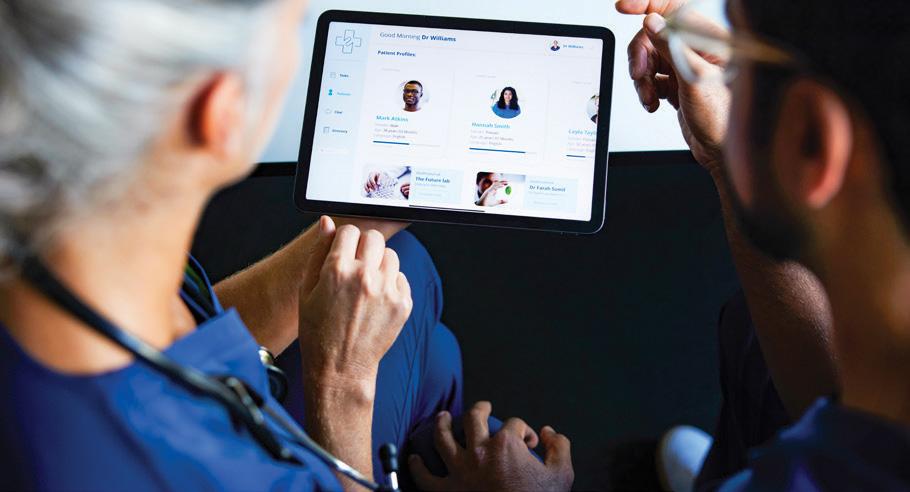
WORDS: ZAINAB MANSOOR
Healthcare providers have been technically focused on sick care, treating those who were ill. In fact, many times it is a misnomer to call it healthcare as it is more of sick care. This is changing slowly with healthcare organisations encouraging people to make good health a top priority”
2045, according to the International Diabetes Federation. Meanwhile, an estimated 17.9 million people died from cardiovascular diseases in 2019, constituting 32 per cent of global deaths, according to WHO.
To avoid challenging health scenarios, individuals can induct a few protocols within their lives for e ective health management. Regular medical checkups and screenings as well as immunisations are some of the preventive measures that can prove beneficial for holistic wellbeing.
“It will be advisable for people to screen for lifestyle diseases like hypertension, diabetes and hyperlipidemia, etc. through routine screening which will allow these to be detected quite early to prevent life threatening diseases in future. People who are at risk must also undergo mental health screenings in addition to physical ones. Apart from this, there is also dental and eye health to consider, which are as important. The early detection of related issues can help prevent future complications as well,” explains Dr Moopen.
Much like other industries, technology has been a growth driver across healthcare. Technological innovation in recent years has not only helped change the way individuals approach healthcare but has also transformed patient engagement. From wearables to virtual consultations to real-time data collection, technology has eased the transition from reactive to routine care.
“Healthcare providers are relying more and more on technology and digital services. Wearables such as Fitbit are a core
AN TO GROW TO 643 MILLION 2045
ESTIMATED 17.9 MILLION TO GROW TO 783 MILLION
PEOPLE
DIED FROM CARDIOVASCULAR DISEASES IN 2019, CONSTITUTING 32 PER CENT OF GLOBAL DEATHS

part of this technological shi t and can help individuals and healthcare providers identify preventive care opportunities by working with information such as heart health, sleep and physical activity,” notes Prateek Kewalramani, head of Marketing, Fitbit - MEA at Google.
Wearables are expected to gain further traction - the International Data Corporation forecasts that the wearables market will record a five-year compound annual growth rate of 5.1 per cent, with unit shipments reaching 628.3 million by the end of 2026.
“We’ve come to be aware of wearable devices as smart watches, whose features include tracking physical activity, monitoring heart rates and helping people get fit. But the potential of wearable devices, including smart patches and monitoring devices, has not been fully realised,” says Akram Bouchenaki, CEO of Abdul Latif Jameel Health.
“As both patients and doctors become more comfortable using these devices, their adoption will grow, helping capture real time data, detect, and manage chronic conditions and avoid serious illnesses.”
Transitioning from reactive action to preventive care will not only ease the burden on healthcare service providers but also help pare chronic health conditions and inculcate a culture of holistic wellbeing.


By 2050, the world is likely to be home to 10 billion people. Two in five of these people will be aged 60 or older, including almost half a billion over 80.
As populations age and people’s lifestyles continue to change, the prevalence of illnesses increases, intensifying the operational and financial pressure on health systems. It’s a scenario that presents challenges for the healthcare sector worldwide. By 2050, public expenditure on health and long-term care is projected to reach almost 13 per cent of GDP for OECD countries.
In other sectors with similarly challenging environments, digital transformation has been vital to improving quality and access to services, while constraining the cost curve. This is even more applicable in healthcare.
In order to improve access to healthcare services, achieve a higher quality of care delivery, and optimise the costs of healthcare provision, governments and healthcare players, both globally and in the Middle East, need to adopt digital solutions.
A significant challenge for healthcare systems in the Middle East is access to care services, particularly access to specialised and advanced care treatments. This is due to multiple factors related to limited workforce availability and the wide geographic distribution. This is an inherent problem in the region which has been exacerbated by the Covid-19 pandemic. However, this is also a challenge that has turned into a blessing, as the pandemic served as a catalyst for the accelerated development of more innovative delivery modes such as telehealth and e-pharmacies.
Innovative e-services and remote care technologies (such as telemedicine and remote monitoring tools) have benefited both patients and medical professionals. Patients have been empowered to access physicians virtually, wherever they are. Physicians have been using technologies to enhance their knowledge and skills and, more importantly, provide better assistance to patients. E-services have been gaining traction in the Middle East, with providers seeing up to 10 per cent of their outpatient consultations move to virtual platforms.
This also translates into tremendous market potential. The value of the global telehealth market is estimated to reach $460bn by 2030. The telemedicine market is also expected to grow exponentially in the Middle East and Africa, in the coming years.

The development of virtual platforms to enhance access does not stop at telehealth. The future might well be in the metaverse, where brick-and-mortar hospitals have less relevance in terms of prevention, diagnostics, and potentially treatment, with care delivered in the comfort of one’s home.
The health ecosystem is already assessing the practicality of many metaverse applications. For example, virtual hospitals are being established,
virtual training for surgeons is developing and the use of augmented reality in surgical procedures is becoming an established practice.
A key benefit of many new technologies is their potential to help minimise errors and improve quality. This is especially important in a sector such as healthcare, where there is no room for mistakes.
These technologies are improving the lives of patients and physicians by performing tasks typically done by humans in less time and with minimal human errors. For example, in prevention, artificial intelligence (AI) techniques are helping to diagnose various diseases such as cancer, Alzheimer’s disease, diabetes, chronic heart disease, and tuberculosis. In terms of treatments, AI-driven robots are assisting with the manipulation and positioning of surgical instruments during operations, enabling surgeons to focus on the more complex aspects of surgical procedures.
Some of these technologies provide information that have previously been inaccessible to physicians. For instance, big data and cloud computing are providing access to higher-quality, more accurate information about patients. This enables a genuine shi t from the reactive “caring for the sick” to “maintaining healthy people,” better early detection, more individualised care, proactive healthcare.
All these technologies will change healthcare as we know it, bringing better prevention, new treatments, and greater accuracy in care provision.
The Middle East is already ahead of the curve in progressively adopting such emerging technologies in healthcare. For example, Saudi Arabia and the UAE have well-developed health systems that arguably have leapfrogged some Western countries in the adoption of digital health technologies. In addition to this, the countries have already begun introducing regulations around the use of AI in medical devices.
Healthcare inflation is intensifying the pressure on healthcare systems around the world, and this is expected to be further aggravated by growing, ageing populations and the increasing burden of diseases.
Innovation can largely support cost control through measures such as automation, early detection, and remote monitoring.
Early detection can positively impact both overall health outcomes and the cost of health services provision. For example, early cancer detection can reduce the cost of cancer treatment by ten times and increase survivability by four times.
Cost reduction should also be considered from a macro healthcare perspective when adopting and implementing digital technologies. While virtual care may be expensive as a setup, it can reduce overall costs of treatment and risk of readmission.
Likewise, remote monitoring technology has helped to improve the control of chronic diseases and post-treatment recovery while assisting with cost reduction. For instance, while diabetes is widespread in our region and its management can be expensive, the integration of remote monitoring technologies into patients’ lives can substantially reduce the costs for the healthcare system as a whole.
Remote monitoring technologies have driven a sharp decline in hospital readmissions and emergency room visits, lowering the cost of care by as much as 16 per cent over five years. These cost savings can subsequently be reinvested in other important areas of care delivery.
While the overall cost of health delivery is expected to continue increasing in the years to come, innovative technologies are expected to constrain them, while supporting the treatment of more patients and establishing an enabled, value-based care system.
As the healthcare sector faces new challenges, emerging technologies are helping leaders to improve performance, increase collaboration across systems, and manage costs. These technologies can streamline processes, automate tasks, and improve workflow at scale.
The vision of healthcare in the future is of a sector completely transformed, with engaged patients embracing a range of digital tools while being responsible and accountable for their own health.
Healthcare will no longer be limited to hospitals but will rather be delivered by health services integrated everywhere.
The industry will e ectively move to a valuebased healthcare system, with an ecosystem that can help people to keep healthy and avoid whatever is avoidable, while finding even more cures for diseases.
REMOTE MONITORING TECHNOLOGIES HAVE DRIVEN A SHARP DECLINE IN HOSPITAL READMISSIONS AND EMERGENCY ROOM VISITS, LOWERING THE COST OF CARE BY AS MUCH AS 16 PER CENT OVER FIVE YEARS
E-SERVICES HAVE BEEN GAINING TRACTION IN THE MIDDLE EAST
With the rapid changes across industries, companies are increasingly competing to stay at the forefront of helping businesses and society create safer and more efficient surroundings with the latest technology. Innovations in the industry have increased opportunities and possibilities of videos and how people and the government can use them.
As technology progresses, data-driven video technology will substantially alter the healthcare industry. Data-driven video technology has the ability to precisely identify when a patient
 Paul Park, regional director – MENAT, Milestone Systems
Paul Park, regional director – MENAT, Milestone Systems
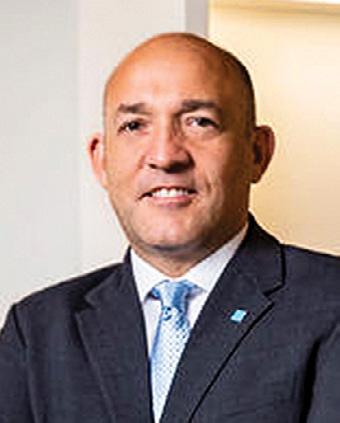
requires immediate attention. When it comes to building a better hospital environment and providing suitable patient care facilities, datadriven video technology can alert the hospital staff as per the patient’s requirements, providing immediate medical attention without the need for constant manual monitoring.
Data-driven video technology can keep an eye on patients from their homes or in non-hospital environments, allowing medical professionals to gather real-time updates on their recovery progression. 02.
Data-driven video technology can help record and analyse surgical procedures (with the patient’s consent), providing valuable data for training and research purposes. 03.
Data-driven video technology can help enhance medical imaging by providing real-time data and analysis.
Data-driven video is, therefore, emerging as a technology that is set to transform the global healthcare landscape, potentially helping to save thousands of lives.
However, although this technology has countless benefits, the sector must prioritise the legislation of patients’ data and privacy protection. It is also equally important to ensure all the key stakeholders are educated about this allimportant innovation and the operational gaps it’s intended to fill.
This will be crucial in getting everyone to buy into this exciting concept and, most importantly, to avoid any regulatory pitfalls that may arise following its deployment.
Healthcare professionals must, therefore, formulate uncompromising rules and regulations on how data-driven video technology can and cannot be operated, adhering to the requirements and privacy concerns. The future will witness infinite opportunities as technological advancements persist to mature.
ADVANCES IN TECHNOLOGY, INCLUDING IMAGE SENSORS, NOW MAKE HEART RATE VARIABILITY MEASUREMENT ACCESSIBLE TO ANYONE WITH A CHEST STRAP OR SMARTPHONE, SAYS BLOOMBERG’S TIM CULPAN

For centuries, doctors have turned to a variety of vital signs to quickly assess the wellbeing of patients. A visit to the ER these days might result in as many as five measurements being taken, each offering unique clues as to what’s going inside the complex human body. Recently, though, a new number has popped up that may turn out to be the single most useful piece of information available to understand someone’s underlying health condition.
Heart rate variability (HRV) offers insights into recovery from illness, injury or exercise, can track levels of physical and emotional stress, and even act as a predictor of cardiac failure. Advances in technology, including image sensors, now make HRV measurement accessible to anyone with a chest strap or smartphone.
Among the more common measures, heart and respiratory rate are the simplest to take– you just need a watch with a second hand to count. More specialised equipment is needed for body temperature, blood-oxygen level and blood pressure,
IN THE PAST DECADE, PROGRESS HAS GONE SO FAR AS TO ALLOW AN IPHONE’S CAMERA AND FLASH TO BE USED TO SENSE BLOOD FLOWING THROUGH THE FINGERTIP AND ACCURATELY RECORD PULSES
but they’re also quite straightforward. The history of blood-pressure measurement dates back 300 years, when Reverend Stephen Hales stuck tubes into a horse to see how high the column of blood would climb. Today, you merely need an arm cuff attached to some electronics.
Whereas heart rate provides beats per minute, variability shows the change in time gap between those cardiac contractions. Heart beat is highly correlated with respiration: It speeds up as you breathe in, and slows when you exhale - and this difference provides a measure of variability. But when the body is tired, the disparity in heart rate between inhalation and exhalation narrows.
Heart rate variability is a little more complicated to capture than traditional metrics because more precise instruments are required to detect, time and record beats of the heart, and then run the statistical analysis to calculate variability. Two patients can have exactly the same heart rate (HR) but differing gaps (HRV), so accuracy is crucial.
Hales had observed the connection between heart rate and breathing, while German physician Carl Ludwig later noted that it changed
according to phases of the respiration cycle. But it wasn’t until the mid-1990s that modern standardised measurements of HRV started to be widely agreed upon, just as research pointed to the metric’s value as a predictor of mortality following heart attack.
Electrocardiography (ECG) machines are a gold standard in heart monitoring and can provide a measurement of HRV. But they’re cumbersome and expensive.
More advanced semiconductors have enabled better sensors to take accurate readings from a chest strap. In the past decade, progress has gone so far as to allow an iPhone’s camera and flash to be used to sense blood flowing through the fingertip and accurately record pulses.
This ease of use has spurred a flurry of new apps and gadgets, and a surge in research on how HRV works, what it measures, and how it can be used.
Among the many processes that regulate the human body is the autonomic nervous system, which controls functions including digestion, breathing, and heart rate. Within this system are two branches – sympathetic and parasympathetic – that work as a kind of yin-yang, balancing out each other according to the body’s needs.
We tend to think of a “normal” heart rate as being around 60 beats per minute (bpm), however the intrinsic heart rate for humans — when nothing regulates it — is actually close to 100bpm. The parasympathetic system lowers it when resting.
Causing the ebb and flow between sympathetic and parasympathetic systems is a simple thing called stress. This loaded term can sometimes be misunderstood and is often connected to psychological issues such as worry or fear. But even joyful activities may trigger a stress response if they cause strain: happily bench-pressing 100 pounds, sprinting for the bus, or singing in a choir. Injury, illness, lack of sleep, a big night on the town and the trials of daily life all trigger responses in the autonomic nervous system. And HRV can track these changes.
“While heart rate might change only minimally outside of very strong stressors such as sickness or excessive alcohol intake, HRV will show a more marked change,” Marco Altini, who has trained in both data science and human movement, and founded the app HRV4Training, told me recently.

…is collating accurate and usable data. Other metrics such as temperature or blood pressure can be taken instantaneously, compared against
population averages and acted upon immediately. HRV, on the other hand, is very individual and requires the collation of baseline figures over multiple days and in similar circumstances each time. Variability taken while drinking your morning coffee isn’t comparable to a measurement taken after dinner.
The widely accepted approach is to take a reading immediately upon waking every morning — usually from one to five minutes. Polar has a chest strap that pairs with a number of apps including Elite HRV or KubiosHRV, while others such as HRV4Training utilise the camera and flash to sense heart beats.
Some devices such as Garmin smart watches, fitness bands by Whoop, and Oura’s smart ring can automatically track HRV during sleep, allowing users to keep tabs without having to set aside time. But consumers should be wary that some smart watches are more sporadic in their samplings, which could result in inaccurate data.
Incorporating HRV into daily life remains the biggest challenge. While a bevy of gadgets can now deliver a stress score each day, users need to resist the temptation to over-interpret a single day’s feedback or chase a “perfect number.” Doing so can lead to the deleterious nocebo effect.
“Using HRV as feedback can help us make meaningful adjustments before we have dug ourselves into a hole,” Altini notes. “While in the past decade we got a lot better at measuring it, in the next one we might get better at implementing meaningful interventions, starting with the usual suspects: exercise, diet, sleep and forms of mindfulness.”
While we now have this powerful new healthcare metric at our fingertips, life still can’t be distilled down to a single number. Looking after ourselves cannot be outsourced to gadgets and data.
WHILE A BEVY OF GADGETS CAN NOW DELIVER A STRESS SCORE EACH DAY, USERS NEED TO RESIST THE TEMPTATION TO OVERINTERPRET A SINGLE DAY’S FEEDBACK OR CHASE A “PERFECT NUMBER.”
DOING SO CAN LEAD TO THE DELETERIOUS NOCEBO EFFECT
Ashish Koshy, CEO of G42 Healthcare, tells Gulf Business that healthcare is in the midst of a dramatic transformation driven by new business models, emerging technologies, and highly engaged consumers

Tell us more about the integrated healthcare platform that follows the Mubadala Health and G42 Healthcare merger. How will it impact the UAE healthcare sector?
G42 Healthcare has joined forces with Mubadala Health to create a new, first-of-its-kind integrated healthcare entity. Bringing together G42 Healthcare’s unique medical and data-centric technologies and Mubadala Health’s world-class patient care, we seek to revolutionise the regional healthcare landscape and deliver a new approach to personalised, patient-centric care.
Operating at the forefront of medical research and innovation, the new entity will deliver pioneering clinical solutions to help solve the world’s most critical health and diagnostic challenges.
How is the company accelerating digital transformation in healthcare?
As we step into the next era of medicine, much of what we do today, will be done differently tomorrow. From how we evaluate patients to managing claims, we are creating the best possible outcomes to healthcare challenges.
Our technology is at the forefront of healthcare advancement. We harness the power of technology to
positively impact important stakeholders in the value chain like hospitals, insurance and healthcare providers, pharmacy chains and pharma players.
We believe the integration of AI technology, genomics and clinical data has the potential to revolutionise healthcare by improving patient care and advancing medical research.

We have recently joined forces with Malaffi, the region’s first health information platform, to expand the digital health footprint in Abu Dhabi and enhance healthcare in the region using cutting-edge technologies and data analytics. Together, we hope to bring new and innovative solutions to the healthcare industry in the region, especially in the domain of data analytics and personalised health.
If the future of healthcare is precise, preventive and personalised – what are the drivers of this transformation?
In the future, healthcare strategies will be designed to empower us to prevent diseases rather than seek treatment. Patients will receive personalised health solutions in ways that are integrated seamlessly into their daily lives. In fact, many analysts predict that in 20 years from now there will be a shift not just from ‘sick care’ to ‘healthcare’ – but from ‘healthcare’ to ‘health’.
We will continue to face growing incidences of disease, but the difference will be that through science, data, and technology, we will be able to identify it earlier, intervene proactively, and help societies effectively and actively sustain their wellbeing.
Precision medicine aims to tailor the right treatment for the right patient at the right time. This evolving world of personalised medicine includes emerging innovations such as biomarkers, targeted therapies and data to enhance healthcare offerings for consumers.
Covid-19 has already revealed how vulnerable the healthcare industry is to change and its need for structural and technological transformation. We are amidst a dramatic transformation driven by new business models, emerging technologies, and highly engaged consumers.
The Omics Centre of Excellence in Masdar City is one of the largest gene sequencing farms in the world. How is multi-omics transforming healthcare?
Multi-omics is bringing in a revolution in health and disease discovery. We are expanding our research based on advanced omics to further the detection and diagnosis of rare and chronic disease and complement real world evidence-based healthcare in the UAE.
The centre is invested in the accentuated power of genomic, clinical and cross-disciplinary data that enables healthcare transformation.
Being the facilitators of the Emirati Genome Program (EGP), we now have the capabilities to partner with national governments to offer population genomics programmes as a precursor for precision medicine and have the expertise across agri-genomics and metagenomics. We are investing the returns of EGP to expand our service offering and build the first-of-its-kind multi-source biobank in the UAE.
By offering end-to-end multi-omics solutions, we are supporting the transition from generalised treatments to personalised, preventive medicine.
Why are population health programmes so critical to public health today?
Population health programmes address the underlying social, economic, and environmental factors that contribute to health outcomes. These programmes aim to improve the overall health of a community by addressing the root causes of illness and disease, rather than just treating symptoms.
By addressing these underlying causes, population health programmes can help to reduce health disparities and improve the overall health and wellbeing of a community.
A successful population genomics programme unites the medical and research communities, governments, and industry into a cohesive strategy to deliver improved outcomes, more efficient population health management, and accelerated discovery through translation.
How can AI be used to shield society from potential health threats?
Artificial Intelligence (AI) can be used to create models that can predict the likelihood of a disease outbreak or the spread of an infectious disease. These models can be used to identify at-risk populations and to guide public health officials in the development of interventions and response plans.
Increasingly, AI is being leveraged in augmenting environmental monitoring and safeguarding public health.
Our Wastewater Monitoring Lab for example can provide an early warning for potential contaminants and threats to public health and the environment. Advanced AI applications enable real-time information generation on wastewaterbased epidemiology to predict the spread and escalation of outbreaks and optimise the allocation of healthcare resources. The degree to which wastewater testing programmes have sprung up over the past year is a testament to their utility for monitoring and protecting community health. As these continue to expand, we are enabling timesaving in our workflows while still generating actionable data, which is critical to our continued success and innovation.
How are public-private partnerships impacting on the UAE’s healthcare sector?
A world-class healthcare sector requires the collaboration of public and private players to leverage one another’s strengths that can ultimately lead to unlocking the full potential of personalised and preventative healthcare.
We recognise that public private partnerships are crucial to driving progress and strategic collaborations can help fast-track sustainable healthcare solutions.
The forward-thinking UAE government has been forthcoming in involving private players, like us, whether it’s facilitating the world’s first Phase 3 Covid-19 trial for an inactivated vaccine or the Emirati Genome Program to safeguard public health and predict accurate treatment and prevention strategies for the current and future local population.
When public-private players are committed to pushing the boundaries of innovation, it results in impactful solutions across the healthcare value chain and accelerates transformations.
We have recently joined forces with Malaffi, the region’s first health information platform, to expand the digital health footprint in Abu Dhabi and enhance healthcare in the region using cutting-edge technologies and data analytics. Together, we hope to bring new and innovative solutions to the healthcare industry in the region, especially in the domain of data analytics and personalised health”
better science and promising weight-loss results from the new class of repurposed diabetes drugs are spurring a roaring comeback for medicines to treat obesity.

Three years ago, drugmakers and laboratories around the world responded to the pandemic with Covid-19 vaccines. Now that the urgency has faded, they’re collectively turning attention to an older pandemic: obesity.
Companies including Eli Lilly & Co and Pfizer are tailgating Novo Nordisk A/S, the first mover into the market with its highly effective Wegovy injection that mimics a weight-related hormone called GLP-1. Amgen was also among companies presenting at the JPMorgan Healthcare Conference in January with a potential obesity entrant. The companies are aiming for the market with versions that either melt off more pounds, have less frequent dosing or don’t require injection.
The search for a safe, effective slimming drug been long and torturous. Prescriptions for the combination of fenfluramine and phentermine, known popularly as fen-phen, soared to more than 18 million in 1996 after the success of a small study, then crashed after it was linked to heart disease and deaths. Now, drugmakers say,
“This is the beginning of a whole new therapeutic area,” Lilly chief scientific officer Daniel Skovronsky said in an interview at the annual health-care confab. One of Novo’s chief competitors in insulin and other diabetes treatments, Lilly is completing a second late-stage trial of its injectable drug tirzepatide. Another trial showed last year that the drug helped patients lose more than 20 per cent of their body weight.
HORMONE MIMIC
GLP-1 is an incretin, a hormone secreted from the gastrointestinal tract that tells the body that food has been eaten. For years, Lilly and Novo have been developing drugs targetting the receptors for incretins, first for diabetes and now for obesity.
By mimicking this natural biology, the new drugs appear to make people feel less hungry, Lilly’s Skovronsky said. They also help reduce
There are several types of incretins and nextgeneration drugs being explored in the hope of helping obese patients shed more poundsGLP-1 IS AN INCRETIN, A HORMONE SECRETED FROM THE GASTROINTESTINAL TRACT THAT TELLS THE BODY THAT FOOD HAS BEEN EATEN
blood glucose levels, which can help many people with both obesity and diabetes.
There are several types of incretins, and nextgeneration drugs are aiming at multiple targets in hopes of helping patients shed more pounds. Lilly’s tirzepatide, for example, mimics a second incretin along with GLP-1, as does Amgen’s experimental AMG 133.
With nearly three in four US adults considered overweight or obese, Wall Street has big expectations for the drug class. The overall obesity market will reach about $30bn by 2030, according to Cowen’s analysts, with Lilly’s tirzepatide seeing more than $11bn of those sales. That would overtake the more-than $7bn in sales estimated for Novo’s Wegovy.
The drugs’ high cost – Wegovy costs $1,350 a month – and lack of insurance coverage for obesity medicines present a key barrier to uptake. “Outdated notions and persisting misconceptions” about the nature and seriousness of obesity stand in the way of effective weight-loss medications’ use, the health nonprofit ECRI said in January. The group is appealing to insurers and politicians to change policies on paying for FDA-approved weight loss medications, Marcus Schabacker, the group’s president and CEO, said in an interview. The drug class “seems to be working, it seems to be safe, it seems to be effective,” he said.
Although it’s in early-stage trials, Amgen’s AMG 133 is already the focus of investor interest. Patients on the highest dose saw an average loss of 14.5 per cent of their weight after 12 weeks of treatment in an early stage trial, according to results released in December. Although other companies are closer to the market, Amgen’s is still likely to be useful, said David Reese, the drugmaker’s executive vice president of research and development.
“It’s an area that’s obviously exploding right now,” he said in an interview. “It’s becoming a field unto itself.”
Pfizer is also testing two drugs that hit the GLP-1 pathway. While Wegovy is injectable, Pfizer’s drugs can be taken as a pill, which the company is betting will prove to be a crucial advantage.
“GLP-1, clearly everybody’s excited about that,” CEO Albert Bourla said in a January 9 fireside chat at the San Francisco conference. “This is a market that will grow to $90bn altogether, and we are very confident on that given the current size of the market and the current growth rates.”
Bourla added that Pfizer could capture about $10bn of that market. A spokesperson for Pfizer said the $90bn figure referred to the combined obesity and diabetes markets for the GLP-1 class of drugs.
Novo is also developing CagriSema, a combination of Wegovy’s main ingredient, called semaglutide, and another drug that targets an eating hormone. And it’s developing a pill version of semaglutide.
Lilly’s tirzepatide is on the market for diabetes under the brand name Mounjaro. While it hasn’t been approved for obesity, some doctors are already recommending it for weight loss. Doctors are permitted to prescribe drugs for unapproved uses, a practice called offlabel prescribing. Demand for Mounjaro and Ozempic, another GLP-1 drug from Novo, has already led to shortages.
Lilly has started a rolling submission to the Food and Drug Administration that will allow it to very quickly submit the new data to the FDA around mid-year, assuming the second final-stage trial succeeds, Skovronsky said. Depending on when and what regulators decide, the drug could be on the market for obesity as early as the year’s end, he said.
The drugmaker is working to make sure it has enough tirzepatide on hand so it doesn’t repeat the supply issues that afflicted Novo. It’s also testing the drug in obesity-linked conditions such as sleep apnea and heart failure, to see if patients benefit.
“We are adding new factories and making it as quickly as we can,” Skovronsky said. “The potential here is large.”
THE OVERALL OBESITY MARKET WILL REACH ABOUT $30BN BY 2030, ACCORDING TO COWEN
WITH LILLY’S TIRZEPATIDE SEEING MORE THAN $11BN OF THOSE SALES THAT WOULD OVERTAKE THE MORE-THAN $7BN IN SALES ESTIMATED FOR NOVO’S WEGOVY
PFIZER IS ALSO TESTING TWO DRUGS THAT HIT THE GLP-1 PATHWAY. WHILE WEGOVY IS INJECTABLE, PFIZER’S DRUGS CAN BE TAKEN AS A PILL, WHICH THE COMPANY IS BETTING WILL PROVE TO BE A CRUCIAL ADVANTAGEWITH NEARLY THREE IN FOUR US ADULTS CONSIDERED OVERWEIGHT OR OBESE, WALL STREET HAS BIG EXPECTATIONS FOR THE DRUG CLASS
The Covid-19 pandemic, climate crisis, humanitarian emergencies and other shocks reinforce the fragility of health and human security.
Life expectancy - our gold standard measurement of global health - has declined for two years running in the wake of Covid-19. Regaining lost ground on the health-related SDGs, preparing for future crises, and realising a world where both people and planet
thrive is crucial”

The chief strategy officer of Arab Fashion Council talks about key regional fashion trends, the growing influence of Arab Fashion Week and how social media has transformed consumer behaviour p.68
Audemars Piguet and Dreamscape Immersive have developed an experience that plunges participants into a wonderful world where they become the actors. Titled TheClockwork Forest, this project will be available at Dreamscape’s Geneva location beginning March 2023 for a limited period of time.

“Careful assessment of the ecological impact of construction works and the required mitigation measures is fundamental to the successful delivery of all of our projects, so we are doing as much as possible to decarbonise the supply chain and reuse materials throughout the construction process.”
Peter Fitzhardinge, acting head of Tourism, Neom
REGION’S BIGGEST SHOWCASE OF GLOBAL AND REGIONAL LITERATURE RETURNS ON FEBRUARY 1, WELCOMING BOTH OLD AND NEW FRIENDS TO DUBAI
 BY NEESHA SALIAN
BY NEESHA SALIAN
Thousands of book lovers from all over the region and beyond will converge on Dubai, as the Emirates Airline Festival of Literature unfolds from February 1-6. In terms of scale, in 2022, the festival reached more than 105,000 people, in-person and via live streaming. This year, with the festival celebrating its 15th anniversary, the number is expected to rise significantly.
“Our focus is on celebrating literature from all over the world, spanning different languages and themes. This year, we are based at the Intercontinental in Festival City, but we’re also holding sessions at the Mohammed bin Rashid Library across the Creek, and we hope to see people travel between the two venues in the ‘time-honoured’ tradition – using an abra as the
emirate’s residents have done for decades,” says Isobel Abulhoul, CEO and trustee –Emirates Literature Foundation.

The theme of this year’s festival is ‘Old Friends’, with authors and speakers from earlier editions returning to meet their fans. Over the last 14 years, more than 1,700 authors from over 100 countries have spoken at the festival. This year, more than 250 of the world’s most prolific writers and thinkers will make their presence felt across 300 events.
Movie, TV and theatre legend Brian Cox, the patriarch Logan Roy from HBO’s critically acclaimed series Succession, is one among them. He will regale audiences with his ‘rags-to-riches’ story, complemented by anecdotes about showbiz and the stars he’s worked with.
International authors taking part include superstar Cecelia Ahern, award-winning Mohsin Hamid, the festival’s ‘old friends’ best-selling authors Jeffrey Archer and Alexander McCall Smith, as well as debut writers Bonnie Garmus (Lessons in Chemistry), Bolu Babalola (Honey and Spice), Jo Browning Wroe, (A Terrible Kindness) and Greg Mosse (The Coming Darkness).
This year’s line-up also includes some of the biggest names in tech and business, including Silicon Valley expert and leadership consultant Ann Hiatt, self-made entrepreneur and co-founder of Happy Skin cosmetics Rissa Mananquil-Trillo, and esports expert Lucy Chow.
“I look forward to my first participation at the festival, and I am honoured to be presenting four separate sessions. I will
be discussing my book, Bet on Yourself, and the business and career lessons I’ve learned during my 15 years working for the CEOs of Amazon and Google. I will also be on a panel, discussing the challenges and opportunities many women experience when working in male dominated industries. My final panel will be about leadership and the challenges businesses face in 2023. I look forward to these conversations as well as my book signings after each event,” says Hiatt.
Ian Fairservice, managing partner and group editor-in-chief of Motivate Media Group, will also be speaking at the festival. In his session, aptly named ‘A Formidable Legacy’, Fairservice will share a compelling account of his own journey, which includes moving to the UAE in 1978, originally working in Dubai’s growing hospitality sector before swiftly moving on to the much lessdeveloped media industry.
For the first time ever, the festival is hosting guest curator, poet and author Lemn Sissay, who will infuse select events with his signature flair and humour.
Representing the region will be Arab literary figures including Ahmed Eisa Al Asam, Mohammed Alnaas, Jalal Bargas, Shahad Alrawi and Tareq Imam. Inaam Kachachi and Yasmina Khadra will lead the conversation around the nuances of narrative Arab fiction.
Festival director Ahlam Bolooki says: “We are overjoyed at the amazing lineup we have secured to celebrate our 15th year, welcoming old friends and new. We are so proud of what has been achieved in that time.”
Bolooki adds that the writers the festival has brought to Dubai over the years have “transported us to new worlds and
different times and introduced us to characters we might not have ordinarily met”.
Desert Stanzas, the festival’s signature event, is a key highlight. This year, the event will mark the opening of the festival, with international voices interpreting and celebrating a narrative that defines the theme through performance, music and feasting.
“It’s going to be an unforgettable experience not just for the audience, but also for the poets who’ll be visiting from around the world. The event will feature a session in the desert, where we’ll be sitting on cushions with sand under our feet, watching stars in the sky and listening to poetry in different languages, with our humanity being the unifying thread. And, it will be followed by the most amazing Emirati feast,” adds Abulhoul.
As always, the festival will feature panel discussions, masterclasses and sessions. This year’s edition will see a series of topics, ranging from the golden visa and its impact on the country’s creative sector to the UAE’s goal of becoming a global metaverse hub, as
well as conversations regarding sustainable food practices and the future of esports and video games, especially in the region.
The festival programme also features workshops, including a crash course on NFTs (NFTs 101), and a masterclass on the metaverse. There’s also a comedy workshop to help people improve their presentation skills.
Foodies can look forward to Top Chef Arabia judge Bobby Chinn curating a oneof-a-kind plant-based dinner using local and sustainably sourced ingredients.
This year’s festival will devote a whole day, on February 3, towards sessions on publishing and the business of books in general.
Among the topics being discussed are TikTok’s impact on the publishing industry, and the impact of social media on publishing, and how authors can protect their rights.
To support aspiring authors in the UAE on their path towards publication, four different international literary agents will be conducting ‘pitching’ workshops at this year’s LitFest so that writing hopefuls can practice pitching their completed projects to other literary agents, as part of their journey towards securing a publishing deal.


The children’s programme is set to be another fun experience. David Walliams is back to entertain children with the exploits of his latest hero Spaceboy, while the multi-talented Ben Miller will treat young audiences to glimpses of his latest adventure, The Day I Fell Into a Story.
Onjali Q Rauf will bring the moving story of The Lion Above the Door, a tale of missing histories and the power of friendships; and Dr Maggie Aderin-Pocock will take children on an epic excursion into space with engaging insights and big questions for young scientists. Author and visual artist Oliver Jeffers returns to the festival. Jeffers’ session will see him explain the history of the world to young readers through stories in a fun, accessible way. Also returning is author, illustrator and ‘draw-along’ star Rob Biddulph. He will help kids channel their inner artist in an interactive event. These are just some of the treasures that await fans. Plus, there’s the unmissable chance of seeing old friends and making new ones. See you there.

FROM SINDALAH TO TROJENA, NEOM IS POISED TO BECOME THE NEXT HOTSPOT FOR LUXURY TRAVELLERS

Tell us about Sindalah and its offerings. Sindalah is one of a group of islands off the coast of Neom and is the region’s first island destination. Expected to welcome guests in Q1 2024, it will provide a gateway to the Red Sea and be home to a yacht club and marina, exclusive hotels, serviced apartments, a beach club and a golf course with 360-degree sea views.

Trojena comprises six districts: Gateway, Discover, Valley, Explore, Relax, and Fun. What are their unique propositions and timelines for delivery?
Trojena is Neom’s year-round mountain destination that will blend and balance sustainable architecture and development with its natural assets to offer an escape for tourists and visitors. It is made up of six districts that provide a wide range of fulfilling activities.
GATEWAY – the access to Trojena and home to the vertical village ‘The Vault’. The district has been designed in harmony with the landscape, with visitors and residents
able to enjoy a new world of possibilities, guided by AI and cognitive technologies. VALLEY – an architectural fresh-water lake and experiential public space designed for events, water sports and serenity

FUN – a high-altitude (2,400 metres above sea level) ski village with over 30 kilometres of slopes down the mountain – a first-of-its-kind experience for the GCC DISCOVER – an advanced technology observatory offering spectacular vistas across the surrounding area and enabling visitors to star gaze in Trojena’s clear night skies.
RELAX – offering dedicated health and wellbeing facilities with treatments and therapies set in the relaxing natural environment of Trojena.
EXPLORE – hosting immersive nature reserves home to unique wildlife, geology and hikes
The construction of Trojena and its clusters is already underway, and we expect to welcome the first residents and visitors in late 2026.
The Line will be a car- and road-free city – how will it facilitate travel?
The Line is a civilisational revolution that will be powered by 100 per cent renewable energy. Our zero-car environment is part of a 100 per cent sustainable transport system.
The Line designs are based on a new concept of ‘zero gravity urbanism,’ which is the idea of layering city functions vertically while enabling inhabitants to move seamlessly in the city in three directions – up, down and across. Travel will be facilitated through The Line’s high-speed public transportation/rail transit, which will allow residents to travel end-to-end in just 20 minutes.
Neom is a six-hour flight from 40 per cent of the world’s population. Which markets is the project targetting?
The location of Neom makes it an appealing destination for local, regional and international guests. The place has its own airport and will eventually have its own dedicated airline to facilitate direct flights to the region from around the world.
Furthermore, it will become a gateway for international trade and travel, targetting a global audience as a result of expanded business opportunities, residential offerings and tourism experiences available in the region. From a tourism perspective, all projects across the Neom will be attractive destinations to visit, as each will deliver a unique experience and showcase the future of livability, business and conservation.
Trojena has a diverse set of offerings for guests throughout different times of the year. Talk us through them.
Trojena will employ human-centric designs to leverage its topography, rich natural landscape, clean air and a climate that’s cooler and more comfortable than the surrounding areas – up to 10 degrees lower, in fact, with sub-zero temperatures and three months of snow in the winter. Trojena’s wellness season takes place between September and November with guests able to prioritise their health and wellbeing through yoga retreats, enjoy artist residencies and attend wellness summits. This is followed by its winter season, which takes place between December and March, when guests will be able to make the most of lower temperatures for activities and events that include skiing, snowboarding, ice skating and a winter fashion week.
“Trojena will employ human-centric designs to leverage its topography, rich natural landscape, clean air and a climate that’s cooler and more comfortable than the surrounding areas – up to 10 degrees lower, in fact, with sub-zero temperatures and three months of snow in the winter”
The adventure season ranges from March to May and will include activities such as a global mountain biking event, high-altitude training, paragliding, climbing and fitness challenges.
Between May to September, Trojena’s lake season will offer ideal temperatures for guests to enjoy outdoor music and food festivals, art fairs, cinema screening and light shows, among an array of other activities.
Finally, tell us about Neom’s commitment to minimising disruption to the local ecology considering the ongoing construction .



Direct access to nature across our region is a key part of what Neom will offer tourists and vistors. Environmental considerations are paramount for Neom and we are committed to protecting 95 per cent of our environment for nature conservation.

Careful assessment of the ecological impact of construction works and the required mitigation measures is fundamental to the successful delivery of all of our projects, so we are doing as much as possible to decarbonise the supply chain and reuse materials throughout the construction process.
For example, all excavated material for The Line’s construction works will be retained for landscaping purposes, with the excavated rock, which is crushed and used as aggregate for concrete production.
Between May to September, Trojena’s lake season will offer ideal temperatures for guests to enjoy outdoor music and food festivals, art fairs, cinema screening and light shows, among an array of other activities”
 BY VEDAT MIZRAHI
BY VEDAT MIZRAHI
Over the past ten years, the Middle East and North Africa’s (MENA) arts sector has grown, supporting economic diversification while also serving as a positive indicator of its success. Deloitte’s Art & Finance Report 2021 reveals that global sales of art and antiques reached over $50.1bn in 2020, where online sales accounted for a higher percentage than the mainstream retail categories.
The number of Middle Eastern investors participating in global sales has risen by 76
per cent over the past five years with the UAE’s participation soaring by 157 per cent. Major art galleries that have opened up in recent years include The Louvre Abu Dhabi, Jameel Arts Centre, Leila Heller Gallery in the UAE, La Fontaine Center of Contemporary Art in Bahrain, Beirut Art Center in Lebanon, Arab Museum of Modern Art in Qatar, Mono Gallery, and Darat Safeya Binzagr Gallery in Saudi Arabia to name a few.
Threats to the global economy have
increased dramatically since the beginning of 2022, leaving many investors wondering how to best protect their portfolios.
The generally accepted rule for investors with varying risk profiles is the same: build a portfolio that can weather the volatility by being well diversified.
Some investors think that diversification is merely allocating funds to different asset classes. However, it is not as simple as that.
The idea behind diversification is to combine different asset classes with different risk profiles and low to negative
correlation. A risk-off event negatively affects some investments, but would have a positive impact on others, reducing the overall risk and drawdown of the whole portfolio.
During the sell-off since the beginning of the year, we have witnessed an increasing correlation between equities, fixed income, and commodities, the main asset classes in a classic portfolio with drawdowns between 5-15 per cent. Especially in an increasing inflationary environment, other diversifiers such as real estate (or hedge funds, private equity funds, venture capital funds for qualified investors) and
fine art can be helpful in improving the risk-adjusted returns of a portfolio.

Art is no longer just appreciated for its aesthetic value, but as an investment. Developments within the art market over the last decade have been followed almost as closely as those within the stock market. Indices tracking the performance of fine art have held up well in the recent economic slowdown with auction houses continuously reporting record prices. Art as an investment has an increasing demand coupled with an absolutely limited supply and
the ability to survive the economic downturns and generate above-inflation returns.
The contemporary art market has performed extremely well over the last 40 years, outperforming the S&P500 Index by 240 per cent since 1986. Over the years, it has ridden out bumps in the stock market and shown that it doesn’t follow the movements of other types of assets.
Finding a good balance between risk and return is the aim of any investment strategy. Different studies show that there are

“During the sell-off since the beginning of the year, we have witnessed an increasing correlation between equities, fixed income, and commodities, the main asset classes in a classic portfolio with drawdowns between 5-15 per cent”
benefits of allocating 15 per cent to 20 per cent of a portfolio to alternative asset classes. Once the domain of institutional and high-net-worth investors, alternative investments continue to grow in popularity and are making their way into the portfolios of retail investors.

Similar to any other investment, the rate of return for alternatives is not guaranteed and past performance is not an indicator
for future performance. However, it is fair to say that an illiquidity premium is usually attached to the alternatives and hence, had generated better returns than more liquid asset classes historically.
The illiquid nature of alternatives and especially the art market is one of the key risks in investing in these asset classes and as a result, their allocation in a portfolio should be determined carefully.
Years ago, people purchased art only due to a personal interest or liking of an artist’s work. However, nowadays an increasing trend in art is solely from an investment perspective due to its unique characteristics as an asset class. Can the MENA region keep up the momentum to become one of the leaders in art investment?
The writer is CFO and chief economist of Mintus, an online art investment platform

“Once the domain of institutional and high-net-worth investors, alternative investments continue to grow in popularity and are making their way into the portfolios of retail investors”
MOHAMMED AQRA, CHIEF STRATEGY OFFICER, ARAB FASHION COUNCIL, TELLS GULF BUSINESS HOW THE COUNCIL AND ARAB FASHION WEEK HAVE REINVENTED THE WORLD’S PERCEPTION OF ARAB FASHION

 BY NEESHA SALIAN
BY NEESHA SALIAN
Tell us about your role at the Arab Fashion Council.

I am Jordanian-American, and grew up in the US. However, I was always intrigued by my roots; and dreamed of building something meaningful in the Middle East. The American fashion industry has been a great source of inspiration and I wanted to create something similar in the Middle East, but of course, driven by the vision of what I knew to be the future of fashion.
I was invited by the board of the Arab Fashion Council for a consulting project following which I was invited to join the board full time. In 2018, I joined the Arab Fashion Council, overseeing strategic partnerships. In 2019, at the age of 25, I was appointed as the chief strategy officer, making me one of the youngest to occupy this position in an international authority of this nature.

My role at the Arab Fashion Council includes implementing short-term and long-term strategies to meet the execution of the council’s mission. In addition, I ensure that the Arab Fashion Council remains a pioneer in the industry, innovating the way forward for our members.
What is the key mission of the council?
The Arab Fashion Council supports the region’s fashion industry by nurturing its creative resources through the entire value chain. Many see the council’s main activity to be limited to coordinating the Arab Fashion Week, which is one of the main initiatives of the council. Beyond that, the
chain, from sourcing fabric and evaluating business models to production support, export and marketing for emerging and established brands within its network.
The Arab Fashion Week is a celebration of the region’s design talent. It enables fashion designers to showcase their creativity to a global audience of buyers, the press and ultra-high-net-worth-individuals. I am proud to say that Arab Fashion Week has been recognised globally as one of the five big fashion weeks through the organisation’s work.
Give us your insights on the Arab fashion industry.
In today’s world, where social media has become a central part of our lives, the fashion scene has definitely been affected by it. This trend has compelled consumers to change their purchase habits in favour of shopping for more “looks” to post on their
platforms. However, their budgets have more or less stayed the same. This trend has translated into shopping for “more” at lower prices. From here, ready couture has come to replace traditional haute couture, enabling the client to purchase a piece produced in limited quantity while allowing alteration and customisation from designers.
Besides, the region is starting to shift from following fashion trends mainly from the West to becoming a nascent trendsetter and exporter. The Arab consumer today shops for more emerging and less famous brands, which has democratised the market and motivated new local and regional designers to start their businesses.
In addition to that, sustainability is becoming a priority. Consumers are happy to select a sustainable brand if the price point is right for them. Organisations and fashion houses are increasingly growing their interest in becoming more sustainable. However, there is a need to enhance the formula of supporting these brands in a way that subsidises the high cost of sustainable materials so this can overcome the competitive prices offered by fast fashion.
How has AFC been supporting Arab designers over the years?

Over the last seven years, Arab Fashion Week has showcased hundreds of Arab
designers coming from the UAE, Saudi Arabia, Qatar, Lebanon, Libya, Iraq, Jordan, Tunisia, Algeria, Egypt and Palestine.

We work on giving designers the proper media exposure and help them innovate and commercialise their creativity with fashion businesses via partnerships and collaborations, particularly with big brands. Examples of these include: Jean Louis Sabaji and Barbie, Zaid Farouki and BIC, and Yara Bin Shakar and Godaddy.
Tell us about the latest edition of the Arab Fashion Week held in Dubai, in October last year. What were the highlights?
The last edition of the Arab Fashion Week in October, featuring the women’s AW 2022/23 and ready-to-wear SS 2023 collections, garnered more than 32,500 RSVP registrations, the highest in the history of the event, as well as a selection of 35 runway shows, one “history-making” collaboration between Barbie, the 2021 recipient of the Fashion Icon Award, and Lebanese couturier Jean-Louis Sabaji.
We also had unique events such as #SheCreates by META event, envisaged to highlight the work of local female entrepreneurs, leaders and advocates, all of whom are shaping the region’s future. In what was an occasion of firsts, The Giving Movement reinvented sustainable athleisure with the debut of the FiftyMade line.
A strong presence of buyers from Asia, Europe, the Americas, and the Middle East was also in attendance. In addition, a growth in international media was also noted as worldwide fashion leaders converged in Dubai for fashion week.
Tell us about AFC’s support of sustainable fashion brands.
Considering the fashion industry is one of the biggest contributors to global warming, the Arab Fashion Council has founded the AFC Green Label, an initiative launched during the Arab Fashion Week’s 6th edition in Dubai in May 2018.

The objective of the AFC Green Label is to promote a responsible approach to the environment by selecting ethical materials and following the guidelines of the United Nations Sustainable Development Goals.
Furthermore, aiming for a better tomorrow, AFC always supports sustainable fashion brands/designers to showcase their collections to a big audience during Arab Fashion Week.
A dedicated hub for the regional startup and SME ecosystem
A startup that produces portable solar panel 'factories', a handy financial literacy app for young children and a company that creates anti-microbial textile products are in the spotlight this month

were not only applicable in space, but also on Earth, where it could be used as an economically attractive, environmentally friendly, and flexible alternative to solar panel manufacturing. What was only an idea in 2014, turned into a business in 2018 and has grown and flourished into a company with three locations worldwide and a product ready for market.
How has being a member of the Mohammed Bin Rashid Innovation Fund's (MBRIF) accelerator programme helped expedite your growth?
challenges of the UAE and Middle East, and to fine-tune our plans accordingly.
Tell us about your o ering and its relevance to energy security both on the planet and o .
The TerraBox is a moveable solar panel factory, using locally available raw materials and electricity as its only inputs. The main value the TerraBox o ers is:
A per watt price reduction of 30 per cent compared to conventional silicon solar panels (our panels are cheaper than Chinese panels).
Joost van Oorschot, founder and CEO, Maana Electric
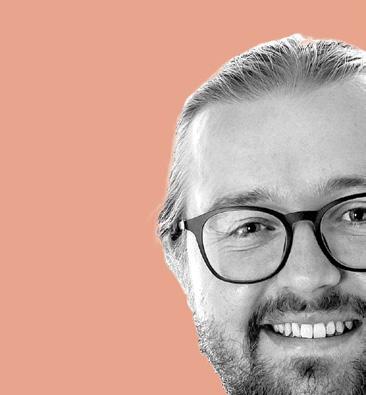
Tell us about your company and what inspired you to start it.
Maana is a combination of the words 'Maan' which means Moon in Dutch and 'Mana', which means power in Polynesian languages. This perfectly describes our 'origin' story, as Maana was founded from our aspirations and research into in situ resource utilisation (ISRU) technologies for producing solar panels on the Moon, Mars and beyond.
During our research, we discovered that the technologies being developed
We consider the Middle East, and particularly the UAE, as a great territory in terms of expansion. First, the country is very active in space exploration and there are many opportunities to scale the innovative technologies that we are developing. Our engineers also have a chance to participate in pioneering space programmes. Secondly, the region is transitioning quickly to renewables and solar.
A product like our TerraBox, a mobile containerised solar panel factory able to produce solar panels using only sand and electricity, fits particularly well within the strategy to be more independent while fostering local manufacturing.
The MBRIF programme was very useful to better understand the specific
Local production, reducing supply chains, associated emissions and enabling the local economy.
Produces solar panels with a vast
TERRABOX OFFERS
A PER WATT PRICE REDUCTION OF 30 PER CENT COMPARED TO CONVENTIONAL SILICON SOLAR PANELS
reduction of CO2 emissions and chemicals usage in the production process.
Tell us about the technology driving your product. What makes it unique?
TerraBox utilises the latest ISRU and automated 4.0 processes to revolutionise the way in which panels are produced. The TerraBox is a �factory in the field’, producing photovoltaic (PV) panels in a portable automated plant operated remotely. It requires only sand as the raw material input and, initially, electrical power supply until it has produced
enough panels to run autonomously with the power generated by those panels. Each panel produced can be installed to start generating electricity.
We are using the most advanced developments in mechanical, thermal and electrical engineering. We are specialists in mining, metallurgy and material science. The TerraBox will be fully remote controlled and embedded with sensors. Once our fleet of TerraBoxes will be deployed across the world, we will collect a massive amount of data which will be processed via machine learning
for continuous improvement of our machines and operations.
By providing an in-situ solution that simplifies the manufacturing process chain and cuts costs, we offer a real and short-term solution for sustainable power generation to curb global warming while reducing costs for developers. Compared with panels produced conventionally, we are lowering the levelised cost of electricity, improving the financial viability of solar projects. We provide a safe disposal of the PV panels, and we reduce disposal costs, due to almost zero carbon emissions, no toxic chemicals and no hazardous waste.
Solar panels are 99.9 per cent recyclable by TerraBox. Plus, there’s no carbon offset versus four years for typical panels to offset CO2 emissions from manufacturing.
Shed some light on the funding you have received and how you plan to use it. We've been able to develop the company, thanks to large R&D contracts with the Luxembourg Space Agency and the European Space Agency, as they support our long-term vision to become the utility company of the solar system.
Recently, we've started welcoming private investors on board; it’s something we will continue in the coming years to pursue our growth.
In 2023, we will have our 1MW prototype TerraBox. We are aiming at deploying the technology in UAE with a first pilot project. In the following years, we will pursue our expansion with commercial projects around the world. Our plan is to have multiple plants producing our TerraBoxes on all continents and operate a large fleet of TerraBoxes to deliver gigawatts of solar panels.

“TERRABOX UTILISES THE LATEST ISRU TECHNOLOGIES AND AUTOMATED 4.0 PROCESSES TO REVOLUTIONISE THE WAY IN WHICH PANELS ARE PRODUCED. THE TERRABOX IS A �FACTORY IN THE FIELD’, PRODUCING PHOTOVOLTAIC (PV) PANELS IN A PORTABLE AUTOMATED PLANT OPERATED REMOTELY”
TERRABOX SOLAR PANELS ARE 99.9 % RECYCLABLE NO CARBON OFFSET VS FOUR YEARS FOR TYPICAL PANELS TO OFFSET CO2 OF MANUFACTURING
I moved to Dubai a ter a stint in New York with a leading marketing agency. Dubai is a city with massive opportunities.

I briefly worked for a tech startup based here and that’s where I started to really think about gaps in the market and how we could introduce something impactful in the region. A ter several months of researching the market and shortlisting a few potential ideas – the concept of improving financial literacy amonf the youth seemed most impactful.
Firstly, the financial literacy rate in MENA is currently below the global average (30.5 per cent) and at the same time, smartphone adoption among youth is one of the highest in the world. It was a perfect recipe for us to come in and bridge the gap between the two.
Leap’s on a mission to teach kids good money habits at an early age.
The concept of an app that teaches kids money habits really came from spending time with young relatives and noticing parents were still using the points system for rewards. Basically, the same point system my parents used on my brothers and I growing up in the 90s.

That was an eye-opener and I started questioning how something as important as this hasn’t still caught up with technological advancements.

There are many other financial literacy apps in the market, what makes Leap any di erent?
When we first set out to build Leap, we carried out a deep dive into the market to really understand what parents and kids wanted most in a pocket money management app. We used that as a starting point and narrowed down on how can we create an incredibly easy experience that’s designed for both parents and kids.

The app is built from the ground up and puts the combination of financial literacy and user experience at its core. The app encourages a transparent, fun and engaging education in money management that’s very easy to use for both parents and kids.
We’ve made it simple for kids to learn by doing with the parental oversight needed to help guide them along the way.
We’ve also rolled out unique features such as 'Savings on Autopilot' and 'Savings Streaks' and that incentivises responsible spending and saving habits. And there’s more to come: new bespoke features, bundled subscription plans and a few more updates to look forward to.
Ziad Toqan, founder, Leap
“THE APP ENCOURAGES A TRANSPARENT, FUN, AND ENGAGING EDUCATION IN MONEY MANAGEMENT THAT’S VERY EASY TO USE FOR BOTH PARENTS AND KIDS. WE’VE MADE IT SIMPLE FOR KIDS TO LEARN BY DOING WITH THE PARENTAL OVERSIGHT NEEDED TO HELP GUIDE THEM ALONG THE WAY”Kate Brunette-Sireteanu, co-founder, Peace of Mind Products


What inspired you to start your business?
As a mother to a newborn baby, I faced a personal challenge during the initial months of the Covid-19 pandemic. I knew that when the lockdowns ended, I wanted to be able to go out of the house while protecting my daughter from airborne viruses, whether travelling or in public and busy spaces. So I searched the market for an antiviral stroller cover with all the qualities such as breathable, lightweight, fire resistant, anti-viral, anti-bacterial, reusable, water repellant, simple and a ordable, but came up with

THE FINANCIAL LITERACY RATE IN MENA IS CURRENTLY BELOW THE GLOBAL AVERAGE (30.5 PER CENT) AND AT THE SAME TIME, SMARTPHONE ADOPTION AMONGST YOUTH IS ONE OF THE HIGHEST IN THE WORLD


Any challenges creating Leap?
Starting any business has a lot of ups and downs, learnings and of course, challenges. With that said, the UAE has really invested in the startup community by putting policies in place that foster and support entrepreneurship. Setting up base in DIFC made it a lot easier for us to build a strong foundation and be able to hit the ground running – building an app from the ground up and truly turning our vision into reality.
What is Leap’s business model?
Leap o ers a monthly subscription at Dhs20. We will be launching annual and family plans soon so stay tuned.
Have you received any funding? What about your future plans?
We’re pleased to have recently closed our pre-seed round. From the get go, Leap has been an extremely lean business. We take the same mindset of cautious spending that we’re teaching kids as an approach to how we run our business. Spending cautiously and keeping a lean yet e cient approach is something Leap will carry on as we scale up.


nothing. At that moment, I decided to develop the product myself, and from there Peace of Mind Products was born.


What were some of the challenges you faced when starting o ?


In the early days, it was just me on a laptop contacting international suppliers. It is hard to get traction when you do not have a company or are not from a well-known entity. If and when I did get to speak with a company, I could only answer a few technical questions. I was on a steep learning curve and needed assistance. So I engaged a fabric technology agency and brought in a business partner. My approach was to find a way; this attitude
and determination has stood the business and its development in good stead.
Tell us about your o ering, its USP and business model.
Our company ethos is – a go-to trusted brand created by parents for parents, producing custom-designed everyday reusable textile products that we enhance with anti-microbial properties to prevent the build-up of ‘nasties’. Our business model is based on addressing a new core need that our customers are facing in the Covid-19 era, while ensuring there is the potential for an expandable product o ering in the future – to future proof the business’s expansion.
Tell us about the response to your products in the UAE and Middle East. As a newly launched startup, we are in the process of building and establishing our brand. Based on the reception that our launch product has made in the UAE, we are already in the process of producing more and finalising the second as well as third products in the range. The response from customers and investors, who we have been talking to, has been rewarding, especially as we showcase a product that is not available anywhere on the globe for a segment of the community who have been unshielded for the last two and a half years. While we all walked around wearing masks to protect ourselves from airborne particles, our youngsters had no added layer of resistance until we launched our VirusShield Stroller Cover.
Talk us through the development process involved in creating your antiviral fabric technology.
In our development, we have worked with a range of textile technology experts including HEIQ, a Swiss IP Creator, an established global brand in materials and textile innovation. Our fabric is powered by HEIQ Viroblock, the antiviral and anti-microbial technology, which inhibits and neutralises the growth of germs on the fabric’s surface in minutes, minimising the carryover and spread of viruses such as influenza, coronavirus and bacteria including Staph A and E-Coli.
"WHILE WE ALL WALKED AROUND WEARING MASKS TO PROTECT OURSELVES FROM AIRBORNE PARTICLES, OUR YOUNGSTERS HAD NO ADDED LAYER OF RESISTANCE UNTIL WE LAUNCHED OUR VIRUSSHIELD STROLLER COVER"

How is it tested and certified?
Giving our consumers peace of mind is in our business’ DNA – so testing and certification are an important and integral aspect of our development process. Our custom-designed fabric is antiviral, anti-bacterial, fire resistant and breathable that has undergone multiple scientific tests under global standards of ISO, ASTM International, and EN Testing. For the UAE market, it carries the Emirates Conformity Certification which is a local stamp of approval. We go over and above the testing requirements as compared to
the majority of our competitors in the family-care category due to our trusted brand proposition.
Tell us about your future plans.
Having secured exclusivity with our textile technology partner in the non-medical family-care category in the next two years, we will be broadening our product range as the go-to anti-microbial textile-based brand for parents across the region. We will also be working with investors who are aligned to our company ethos and product development plan to support this growth.
“OUR FABRIC IS POWERED BY HEIQ VIROBLOCK, THE ANTIVIRAL AND ANTIMICROBIAL TECHNOLOGY WHICH INHIBITS AND NEUTRALISES THE GROWTH OF GERMS ON THE FABRIC’S SURFACE IN MINUTES”

AWARDS CEREMONY I 15 MARCH 2023
MADINAT JUMEIRAH DUBAI
Find out how creativity has the power to drive progress for people, businesses and for positive change in society. Dubai Lynx has been championing creative excellence in the MENA region for over 15 years, providing a hub for content, networking and benchmarking creativity in the region that drives progress.
Hear from global leaders and visionary thinkers in the creative space and meet with the region›s thriving industry to find out how creativity leads to solutions for your business to grow faster, more profitably and shift culture.
This year Dubai Lynx will feature two main stages: the MENA stage looking at Creativity alongside Vision 2030 as well as the future of creativity in the Middle East. The Global Stage will feature keynotes from global Chief Creatives who will discuss their personal journey, what inspires them to create award winning work as we touch on global trends propelling the industry forward.
Tickets to the Festival are now available online and include access to all content stages, complimentary lunch, coffee break and access to the Official Party on Fort Island on the evening of 14 March where we announce the shortlists for the 2023 Awards.
www.dubailynx.com

In association with Strategic partner Co-sponsor Association partners



